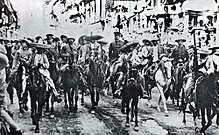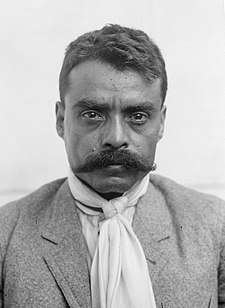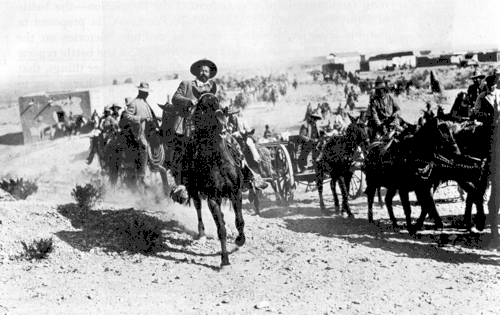Mexican Revolution
The Mexican Revolution (Spanish: Revolución Mexicana) was a major armed struggle, lasting roughly from 1910 to 1920, that transformed Mexican culture and government. Although recent research has focused on local and regional aspects of the revolution, it was a genuinely national revolution.[6] Its outbreak in 1910 resulted from the failure of the 31-year-long regime of Porfirio Díaz to find a managed solution to presidential succession. This meant there was a political crisis among competing elites and the opportunity for agrarian insurrection.[7] Wealthy landowner Francisco I. Madero challenged Díaz in the 1910 presidential election, and following the rigged results, revolted under the Plan of San Luis Potosí.[8] Armed conflict broke out in northern Mexico and Díaz was forced out. In the Treaty of Ciudad Juárez, Díaz resigned and went into exile, new elections were to occur in the fall, and an interim presidency under Francisco León de la Barra was installed. A new election was held in 1911, bringing Madero to the presidency.
| Mexican Revolution | |||||||
|---|---|---|---|---|---|---|---|
 Collage of the Mexican Revolution | |||||||
| |||||||
| Belligerents | |||||||
|
1910–1911: Federal Army led by Porfirio Díaz |
1910–1911: Maderistas Orozquistas Magonistas Zapatistas | ||||||
|
1911–1913: Maderistas |
1911–1913: Forces led by Bernardo Reyes Forces led by the general Mareo Velasques Félix Díaz Orozquistas Magonistas Zapatistas | ||||||
|
1913–1914: Forces led by Victoriano Huerta |
1913–1914: Carrancistas Villistas Zapatistas | ||||||
|
1914–1919: Villistas Zapatistas Forces led by Félix Díaz Forces led by Aureliano Blanquet |
1914–1919: Carrancistas | ||||||
|
1920: |
1920: | ||||||
| Commanders and leaders | |||||||
|
1910–1911: Porfirio Díaz Ramón Corral Manuel Mondragón José Yves Limantour 1911–1913: Pascual Orozco (Fought own revolution after Díaz was overthrown and later sided with Huerta after Huerta took power.) Bernardo Reyes † (Led own revolution until his death in 1913.) Félix Díaz (sided with Reyes and later Huerta after Reyes killed in 1913.) Emiliano Zapata (Sided with Orozco until Orozco sided with Huerta.) Ricardo Flores Magón (POW) 1913–1914: Victoriano Huerta Aureliano Blanquet Pascual Orozco ( † in 1915) Manuel Mondragón (Until June 1913) Francisco León de la Barra Francisco S. Carvajal 1914–1919: Pancho Villa Emiliano Zapata † Félix Díaz Aureliano Blanquet † 1920: Álvaro Obregón |
1910–1911: Francisco I. Madero Pascual Orozco Bernardo Reyes Pancho Villa Emiliano Zapata Ricardo Flores Magón 1911–1913: Francisco I. Madero † José María Pino Suárez † Pancho Villa Venustiano Carranza Victoriano Huerta (Secretly sided with Reyes against Madero until Reyes died in 1913. After Reyes was killed, Huerta launched his own revolution.) Aureliano Blanquet (Also secretly sided with Reyes until his death.) 1913–1914: Venustiano Carranza Pancho Villa Emiliano Zapata Álvaro Obregón Plutarco Elías Calles 1914–1919: Venustiano Carranza Álvaro Obregón 1920: Venustiano Carranza † | ||||||
| Strength | |||||||
|
250,000 – 300,000 |
255,000 – 290,000 | ||||||
| Casualties and losses | |||||||
|
|
| ||||||
|
700,000[5] to 1,117,000[5] civilian dead (using 2.7 million figure) | |||||||
The origins of the conflict were broadly based in opposition to the Díaz regime, with the 1910 election becoming the catalyst for the outbreak of political rebellion. The revolution was begun by elements of the Mexican elite hostile to Díaz, led by Madero, Pascual Orozco, and Pancho Villa; it expanded to the middle class, the peasantry in some regions, and organized labor.[9] In October 1911, Madero was overwhelmingly elected in a free and fair election and took office in November.
Opposition to his regime then grew from both the conservatives, who saw him as too weak and too liberal, and from former revolutionary fighters and the dispossessed, who saw him as too conservative.
In a chaotic period in February 1913, known as the Ten Tragic Days (Spanish: La Decena Trágica), Madero and his vice president Pino Suárez were forced to resign and assassinated. The counter-revolutionary regime of General Victoriano Huerta came to power, backed by the United States ambassador,[10] local business interests, and other supporters of the old order. Huerta remained in power until July 1914, when he was forced out by a coalition of different regional revolutionary forces. When the revolutionaries' attempt to reach political agreement failed, Mexico plunged into a civil war (1914–15). The Constitutionalist faction under wealthy landowner Venustiano Carranza emerged as the victor in 1915, defeating the revolutionary forces of former Constitutionalist Pancho Villa and forcing revolutionary leader Emiliano Zapata back to guerrilla warfare. Zapata was assassinated in 1919 by agents of President Carranza.
The armed conflict lasted for the better part of a decade, until around 1920, and had several distinct phases.[11] Over time, the revolution changed from a revolt against the established order under Díaz to a multi-sided civil war in particular regions, with frequently shifting power struggles among factions in the Mexican Revolution. One major result of the revolution was the dissolution of the Federal Army in 1914, which Francisco Madero had kept intact when he was elected in 1911 and Huerta had used to oust Madero. Revolutionary forces unified against Huerta's reactionary regime defeated federal forces.[12] Although the conflict was primarily a civil war, foreign powers that had important economic and strategic interests in Mexico figured in the outcome of Mexico's power struggles. The United States played an especially significant role.[13] Out of Mexico's population of 15 million, the losses were high, but numerical estimates vary a great deal. Perhaps 1.5 million people died and nearly 200,000 refugees fled abroad, especially to the United States.[3][14]
Many scholars consider the promulgation of the Mexican Constitution of 1917 (Spanish: Constitucion de 1917) as the end point of the armed conflict. "Economic and social conditions improved in accordance with revolutionary policies, so that the new society took shape within a framework of official revolutionary institutions", with the constitution providing that framework.[15] 1920–40 is often considered to be a phase of the revolution, as government power was consolidated, the Catholic clergy and institutions were attacked in the 1920s, and the 1917 constitution was implemented.[16]
This armed conflict is often characterized as the most important sociopolitical event in Mexico and one of the greatest upheavals of the 20th century;[17] it resulted in an important program of experimentation and reform in social organization.[18] The revolution created the resulting political regime, until Mexico underwent an economic liberal reform process that started in the 1980s.[19]
Porfiriato, 1876–1911
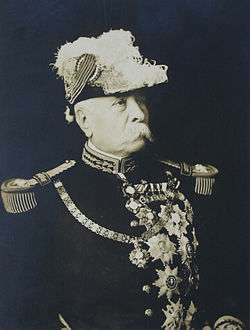
| A graphical timeline is available at Timeline of the Mexican Revolution |
Part of a series on the |
|---|
| History of Mexico |
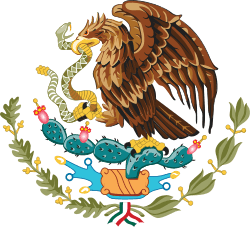 |
|
Spanish rule |
|
| Timeline |
|
|
The Porfiriato is the period in late 19th-century Mexican history dominated by General Porfirio Díaz, who became president of Mexico in 1876 and ruled almost continuously (with the exception of 1880–84) until his forced resignation in 1911.[20] After the presidency of his ally, General Manuel González (1880–84), Díaz ran for the presidency again and legally served in office until 1911. Under his administration, the constitution had been amended to allow unlimited presidential re-election. Díaz had originally challenged Benito Juárez on the platform of "no re-election."[21] During the Porfiriato there were regular elections, marked by contentious irregularities.[22] Although Díaz had publicly announced in an interview with journalist James Creelman for Pearson's Magazine that he would not run in the 1910 election, setting off a flurry of political activity, he changed his mind and decided to run again at age 80.
The contested 1910 election was a key political event that contributed to the Mexican Revolution. As Díaz aged, the question of presidential succession became increasingly important. In 1906 the office of vice president was revived, with Díaz choosing his close ally Ramón Corral from among his Científico advisers to serve in the post.[23] By the 1910 election, the Díaz regime had become highly authoritarian, and opposition to it had increased in many sectors of Mexican society.
In the 19th century he had been a national hero, opposing the French Intervention (Spanish: Intervención francesa) in the 1860s and distinguishing himself in the Battle of Puebla (Spanish: Batalla de Puebla) on 5 May 1862 ("Cinco de Mayo").[24] Díaz entered politics following the expulsion of the French in 1867. When Benito Juárez was elected in 1871, Díaz alleged fraud. Juárez died in office in 1872, and Sebastián Lerdo de Tejada succeeded him. Díaz unsuccessfully rebelled against Lerdo under the Plan de La Noria[25] but later accepted the amnesty offered to him. However, when Lerdo ran for the presidency in 1876, Díaz successfully rebelled under the Plan de Tuxtepec.[26][27]
In his early years in the presidency, Díaz was a master politician, playing factions off one another while retaining and consolidating his own power. He used the rurales, an armed police force directly under his control, as a paramilitary force to keep order in the countryside. He rigged elections, arguing that only he knew what was best for his country, and he enforced his belief with a strong hand. "Order and Progress" were the watchwords of his rule.[28] Although Díaz came to power in 1876 under the banner of "no re-election," with the exception of the presidency of Manuel González from 1880–84, Díaz remained in power continuously from 1884 until 1911, with rigged elections held at regular intervals to give the appearance of democracy.
Díaz's presidency was characterized by the promotion of industry and development of infrastructure by opening the country to foreign investment. He believed opposition needed to be suppressed and order maintained to reassure foreign entrepreneurs that their investments were safe. The modernization and progress in cities came at the expense of the rising working class and the peasantry.
Farmers and peasants both complained of oppression and exploitation. The economy took a great leap during the Porfiriato, as he encouraged the construction of factories and industries and infrastructure such as roads and dams, as well as improving agriculture. Industrialization resulted in the rise of an urban proletariat and attracted an influx of foreign capital from the United States and Great Britain.
Wealth, political power and access to education were concentrated among a handful of elite landholding families, overwhelmingly of European and mixed descent. Known as hacendados, they controlled vast swaths of the country by virtue of their huge estates (for example, the Terrazas had one estate in Sonora that alone comprised more than a million acres). Most people in Mexico were landless peasants laboring on these vast estates or industrial workers toiling for little more than slave wages. Foreign companies--mostly from the United Kingdom, France and the U.S.--also exercised influence in Mexico.
Political system
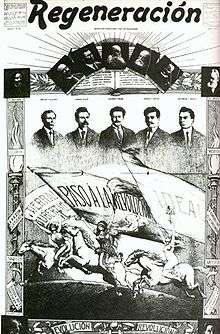
Díaz created a formidable political machine, first working with regional strongmen and bringing them into his regime, then replacing them with jefes políticos (political bosses) who were loyal to him. He skillfully managed political conflict and reined in tendencies toward autonomy. He appointed a number of military officers to state governorships, including General Bernardo Reyes, who became governor of the northern state of Nuevo León, but over the years military men were largely replaced by civilians loyal to Díaz.
As a military man himself, and one who had intervened directly in politics to seize the presidency in 1876, Díaz was acutely aware that the Federal Army could oppose him. He augmented the rurales, a police force created by Juárez, making them his personal armed force. The rurales were only 2,500 in number, as opposed to the 30,000 in the army and another 30,000 in the federal auxiliaries, irregulars and National Guard.[29] Despite their small numbers, the rurales were highly effective in bringing control to the countryside, especially along the 12,000 miles of railway lines. They were a mobile force, often sent on trains with their horses to put down rebellions in relatively remote areas of Mexico.[30]
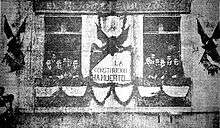
The construction of railways had been transformative in Mexico (as well as elsewhere in Latin America), accelerating economic activity and increasing the power of the Mexican state. The isolation from the central government that many remote areas had enjoyed or suffered was ending. Telegraph lines constructed next to railroad tracks meant instant communication between distant states and the capital.[31]
The political acumen and flexibility Díaz exhibited in the early years of the Porfiriato began to decline. He brought the state governors under his control, replacing them at will. The Federal Army, while large, was increasingly an ineffective force with aging leadership and troops dragooned into service. Díaz attempted the same kind of manipulation he executed with the Mexican political system with business interests, showing favoritism to European interests against those of the U.S.[32]
Rival interests, particularly those of the foreign powers with presence in Mexico, further complicated an already complex system of favoritism.[33] As economic activity increased and industries thrived, industrial workers began organizing for better conditions. With the expansion of Mexican agriculture, landless peasants were forced to work for low wages or move to the cities. Peasant agriculture was under pressure as haciendas expanded, such as in the state of Morelos, just south of Mexico City, with its burgeoning sugar plantations. There was what one scholar has called "agrarian compression," in which "population growth intersected with land loss, declining wages and insecure tenancies to produce widespread economic deterioration," but the regions under the greatest stress weren't the ones that rebelled.[34]
Opposition to Díaz
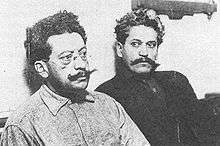
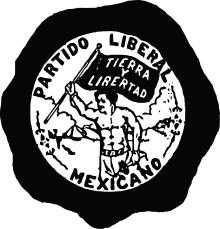
A number of Mexicans began to organize in opposition to Díaz policies that had welcomed foreign capital and capitalists, suppressed nascent labor unions and consistently moved against peasants as agriculture flourished. In 1905 the group of Mexican intellectuals and agitators who had created the Mexican Liberal Party (Partido Liberal de México) drew up a radical program of reform, specifically addressing what they considered to be the worst aspects of the Díaz regime. Most prominent in the PLM were Ricardo Flores Magón and his two brothers, Enrique and Jesús. They, along with Luis Cabrera Lobato and Antonio Díaz Soto y Gama, were connected to the anti-Díaz publication El Hijo del Ahuizote. Political cartoons by José Guadalupe Posada lampooned politicians and cultural elites with mordant humor, portraying them as skeletons. The Liberal Party of Mexico founded the anti-Díaz anarchist newspaper Regeneración, which appeared in both Spanish and English. In exile in the United States, Práxedis Guerrero began publishing an anti-Díaz newspaper, Alba Roja (Red Dawn), in San Francisco. Although leftist groups were small in numbers, they became highly influential through their publications, which helped articulate opposition to the Díaz regime. Francisco Bulnes described these men as the "true authors" of the Mexican Revolution for agitating the masses.[35] As the 1910 election approached, Francisco I. Madero, an idealistic political novice and member of one of Mexico's richest families, funded the newspaper Anti-Reelectionista, in opposition to the continuous re-election of Díaz.
Organized labor conducted strikes for better wages and just treatment. Demands for better labor conditions were central to the Liberal Party program, drawn up in 1905. Mexican copper miners in the northern state of Sonora took action in the 1906 Cananea strike. Starting on June 1, 1906, 5,400 miners began to organize labor strikes. [36] Among other grievances, they were paid less than U.S. nationals working in the mines.[37] In the state of Veracruz, textile workers rioted in January 1907 at the huge Río Blanco factory, the world's largest, protesting against unfair labor practices. They were paid in credit that could be used only at the company store, binding them to the company.[38]
These strikes were ruthlessly suppressed, with factory owners receiving support from government forces. In the Cananea strike, mine owner William Cornell Greene received support from Díaz's rurales in Sonora as well as Arizona Rangers called in from across the U.S. border.[39] This private military force was ordered to use violence in order to combat the labor uprisings, marking the U.S.'s involvement in suppressing the Mexican working class. [40] In the state of Veracruz, the Mexican army gunned down Rio Blanco textile workers and put the bodies on train cars that transported them to Veracruz, "where the bodies were dumped in the harbor as food for sharks".[41] Government suppression of strikes was not unique to Mexico, with parallel occurrences both in the United States and Western Europe.
Since the press was suppressed in Mexico under Díaz, little was published that was critical of the regime. Newspapers barely reported on the Rio Blanco textile strike, the Cananea strike or harsh labor practices on plantations in Oaxaca and Yucatán. Leftist Mexican opponents of the Díaz regime, such as Ricardo Flores Magón and Práxedis Guerrero, went into exile in the relative safety of the United States, but cooperation between the U.S. government and Díaz's agents resulted in the arrest of some.
Presidential succession in 1910

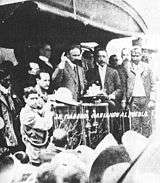
Díaz had ruled continuously since 1884. The question of presidential succession was an issue as early as 1900, when he turned 70.[42] It was his "undeclared intention to step down from the presidency in 1904."[43] Díaz seems to have considered Finance Minister José Yves Limantour as his successor. Limantour was a key member of the Científicos, the circle of technocratic advisers steeped in positivist political science. Another potential successor was General Bernardo Reyes, Diaz's Minister of War, who also served as governor of Nuevo León. Reyes, an opponent of the Científicos, was a moderate reformer with a considerable base of support.[43] Díaz became concerned about him as a rival, and forced him to resign from his cabinet. He attempted to marginalize Reyes by sending him on a "military mission" to Europe,[44] distancing him from Mexico and potential political supporters.
Díaz re-established the office of vice president in 1906, choosing Ramón Corral. Rather than managing political succession, Díaz marginalized Corral, keeping him away from any decision-making.[45]
In a 1908 interview with U.S. journalist James Creelman, Díaz said that Mexico was ready for democracy and that he would step down to allow other candidates to compete for the presidency.[46][47][48] If Díaz had kept to this, the presidency and vice presidency would have been open in 1910. His later reversal on retiring from the presidency set off tremendous activity among opposition groups.
"The potential challenge from Reyes would remain one of Díaz's political obsessions through the rest of the decade, which ultimately blinded him to the danger of the challenge of Francisco Madero's anti-re-electionist campaign."[49]
In 1910 Francisco I. Madero, a young man from a wealthy landowning family in the northern state of Coahuila, announced his intent to challenge Díaz for the presidency in the next election, under the banner of the Anti-Reelectionist Party. Madero chose as his running mate Francisco Vázquez Gómez, a physician who had opposed Díaz.[50] Although similar overall to Díaz in his ideology, Madero hoped for other elites to rule alongside the president. Díaz thought he could control this election, as he had the previous seven;[51] however, Madero campaigned vigorously and effectively. To ensure Madero did not win, Díaz had him jailed before the election. He escaped and fled for a short period to San Antonio, Texas.[51] Díaz was announced the winner of the election by a "landslide". When it became obvious that the election had been fixed, Madero supporter Toribio Ortega took up arms with a group of followers at Cuchillo Parado, Chihuahua on 10 November 1910.
End of the Porfiriato
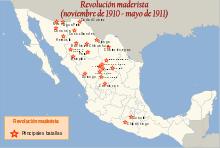
On 5 October 1910, Madero issued a "letter from jail," known as the Plan de San Luis Potosí, with its main slogan Sufragio Efectivo, No Re-elección ("free suffrage and no re-election"). It declared the Díaz presidency illegal and called for revolt against him, starting on 20 November 1910. Madero's political plan did not outline major socioeconomic revolution, but offered the hope of change for many disadvantaged Mexicans.[51]

Madero's plan was aimed at fomenting a popular uprising against Díaz, but he also understood that the support of the United States and U.S. financiers would be of crucial importance in undermining the regime. The rich and powerful Madero family drew on its resources to make regime change possible, with Madero's brother Gustavo A. Madero hiring, in October 1910, the firm of Washington lawyer Sherburne Hopkins, the "world's best rigger of Latin-American revolutions", to encourage support in the U.S.[52] A strategy to discredit Díaz with U.S. business and the U.S. government achieved some success, with Standard Oil representatives engaging in talks with Gustavo Madero. More importantly, the U.S. government "bent neutrality laws for the revolutionaries."[53]
In late 1910 revolutionary movements broke out in response to Madero's Plan de San Luis Potosí. His vague promises of land reform attracted many peasants throughout the country. Spontaneous rebellions arose in which ordinary farm laborers, miners and other working-class Mexicans, along with much of the country's population of indigenous natives, fought Díaz's forces, with some success. Madero attracted the forces of rebel leaders such as Pascual Orozco, Pancho Villa, Ricardo Flores Magón, Emiliano Zapata and Venustiano Carranza. A young and able revolutionary, Orozco--along with Gov. Abraham González--formed a powerful military union in the north and, although they were not especially committed to Madero, took Mexicali and Chihuahua City. These victories encouraged alliances with other revolutionary leaders, including Villa. Against Madero's wishes, Orozco and Villa fought for and won Ciudad Juárez, bordering El Paso, Texas, on the south side of the Rio Grande. Madero's call to action had some unanticipated results, such as the Magonista rebellion of 1911 in Baja California.[54] During the Maderista campaign in northern Mexico, there was anti-Chinese violence, particularly the May 1911 massacre at Torreón, a major railway hub.[55]
Interim presidency May-Nov. 1911
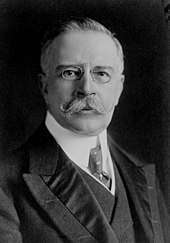
With the Federal Army defeated in a string of battles, Diaz's government began negotiations with the revolutionaries. One of Madero's representatives in the negotiations was his running mate in the 1910 elections, Francisco Vázquez Gómez.[56] The talks culminated in the 21 May 1911 Treaty of Ciudad Juárez. The signed treaty stated that Díaz would abdicate the presidency along with his vice president, Ramón Corral, by the end of May 1911, to be replaced by an interim president, Francisco León de la Barra, until elections were held. Díaz and his family and a number of top supporters were allowed to go into exile.[57] When Díaz left for exile in Paris, he was reported as saying, "Madero has unleashed a tiger; let us see if he can control it."[58]
With Díaz in exile and new elections to be called in October, the power structure of the old regime remained in place. Francisco León de la Barra became interim president, pending an election to be held in October 1911. León de la Barra was considered an acceptable person for the interim presidency, since he was not a Científico, not a politician, but rather a Catholic lawyer and diplomat.[59] He appeared to be a moderate, but the German ambassador to Mexico, Paul von Hintze, who associated with the Interim President, said of him that "De la Barra wants to accommodate himself with dignity to the inevitable advance of the ex-revolutionary influence, while accelerating the widespread collapse of the Madero party...."[60] The Federal Army, despite its defeats by the revolutionaries, remained intact as the government's force, while Madero called on revolutionary fighters to lay down their arms and demobilize. The cabinet of De la Barra and the Mexican congress was filled with supporters of the Díaz regime. Madero campaigned vigorously for the presidency during this interim period, but revolutionaries who had supported him and brought about Díaz's resignation were dismayed that the sweeping reforms they sought were not immediately instituted. He did introduce some progressive reforms, including improved funding for rural schools; promoting some aspects of agrarian reform to increase the amount of productive land; labor reforms including workman's compensation and the eight-hour day; but also the right of the government to intervene in strikes. According to historian Peter V.N. Henderson, León de la Barra's and congress's actions "suggests that few Porfirians wished to return to the status quo of the dictatorship. Rather, the thoughtful, progressive members of the Porfirian meritocracy recognized the need for change."[61]
De la Barra's government sent General Victoriano Huerta to fight in Morelos against the Zapatistas, burning villages and wreaking havoc. His actions drove a wedge between Zapata and Madero, which widened when Madero was inaugurated president.[62] Madero had won the election decisively and was inaugurated as president in November 1911, but his movement had lost crucial momentum and supporters in the months of the Interim Presidency.
Madero Presidency, Nov. 1911–Feb. 1913
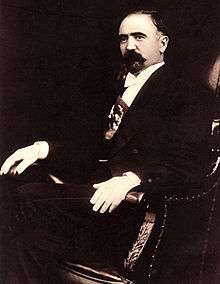
_Pascual_Orozco._(21879503251).jpg)
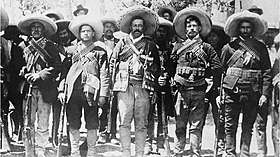
Madero was an inexperienced politician who had never held office before, but his election as president in October 1911, following the exile of Porfirio Díaz in May 1911 and the interim presidency of Francisco León de la Barra, raised high expectations for positive change. However, the Treaty of Ciudad Juárez guaranteed that the essential structure of the Díaz regime, including the Federal Army, was kept in place.[63] Madero fervently held to his position that Mexico needed real democracy, which included regime change by valid election, a free press and the right of labor to organize and strike.
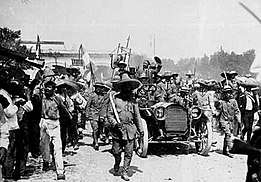
The rebels who brought him to power were demobilized and Madero called on these men of action to return to civilian life. According to a story told by Pancho Villa (one of those who had defeated Díaz's army and forced his resignation and exile), he told Madero at a banquet in Ciudad Juárez in 1911, "You [Madero], sir, have destroyed the revolution . . . It's simple: this bunch of dandies have made a fool of you, and this will eventually cost us our necks, yours included."[64] Ignoring the warning, Madero increasingly relied on the Federal Army as armed rebellions broke out in Mexico in 1911–12, with particularly threatening insurrections led by Emiliano Zapata in Morelos and Pascual Orozco in the north. Both Zapata and Orozco had led revolts that had put pressure on Díaz to resign, and both felt betrayed by Madero once he became president.
The press embraced its newfound freedom and Madero became a target of its criticism. Organized labor, which had been suppressed under Díaz, could and did stage strikes, which foreign entrepreneurs saw as threatening their interests. Although there had been labor unrest under Díaz, labor's new freedom to organize also came with anti-American currents.[65] The anarcho-syndicalist Casa del Obrero Mundial (House of the World Worker) was founded in September 1912 by Antonio Díaz Soto y Gama, Manuel Sarabia and Lázaro Gutiérrez de Lara and served as a center of agitation and propaganda, but it was not a formal labor union.[66][67]
Political parties proliferated, one of the most important being the National Catholic Party, which in a number of regions of the country was particularly strong.[68] Several Catholic newspapers were in circulation during the Madero era, including El País and La Nación, only to be later suppressed under the Victoriano Huerta regime (1913–14).[69] From 1876–1911, relations between the Roman Catholic Church and the Mexican government were stable, with the anticlerical laws of the Mexican Constitution of 1857 remaining in place, but not enforced, so conflict was muted.[70]
During Madero's presidency, Church-state conflict was channeled peacefully.[71] The National Catholic Party became an important political opposition force during the Madero presidency.[72] In June 1912 congressional elections, "militarily quiescent states...the Catholic Party (PCN) did conspicuously well."[73] During that period, the Catholic Association of Mexican Youth (ACJM) was founded. Although the National Catholic Party was an opposition party to the Madero regime, "Madero clearly welcomed the emergence of a kind of two party system (Catholic and liberal); he encouraged Catholic political involvement, echoing the exhortations of the episcopate."[74] What was emerging during the Madero regime was "Díaz's old policy of Church-state detente was being continued, perhaps more rapidly and on surer foundations."[75] The Catholic Church was working within the new democratic system promoted by Madero, but it had its own interests to promote, some of which were the forces of the old conservative Church, while the new, progressive Church supporting social Catholicism of the 1891 papal encyclical Rerum Novarum was also a current. When Madero was overthrown in February 1913 by counter-revolutionaries, the conservative wing of the Church supported the coup.[76]
Madero did not have the experience or the ideological inclination to reward men who had helped bring him to power. Some revolutionary leaders expected personal rewards, such as the young and militarily gifted Pascual Orozco of Chihuahua. Others wanted major reforms, most especially Emiliano Zapata and Andrés Molina Enríquez, who had long worked for land reform.[77] Madero met personally with Zapata, telling the guerrilla leader that the agrarian question needed careful study. His meaning was clear: Madero, a member of a rich northern hacendado family, was not about to implement comprehensive agrarian reform for aggrieved peasants.
%2C_de_Agust%C3%ADn_V%C3%ADctor_Casasola.tif.jpg)
In response to this lack of action, Zapata promulgated the Plan de Ayala in November 1911, declaring himself in rebellion against Madero. He renewed guerrilla warfare in the state of Morelos. Madero sent the Federal Army to deal with Zapata, albeit unsuccessfully. Zapata remained true to the demands of the Plan de Ayala and in rebellion against every central government up until his assassination by an agent of President Venustiano Carranza in 1919.
.jpg)
The brilliant northern revolutionary General Pascual Orozco, who had helped take Ciudad Juárez, had expected to become governor of Chihuahua, a powerful position. In 1911, although Orozco was "the man of the hour," Madero gave the governorship instead to Abraham González, a respectable revolutionary, with the explanation that Orozco had not reached the legal age to serve as governor, a tactic that was "a useful constitutional alibi for thwarting the ambitions of young, popular, revolutionary leaders."[79]
Madero had put Orozco in charge of the large force of rurales in Chihuahua, but to a gifted revolutionary fighter who had helped bring about Díaz's fall, Madero's reward was insulting. After Madero refused to agree to social reforms calling for better working hours, pay and conditions, Orozco organized his own army, the "Orozquistas", also called the "Colorados" ("Red Flaggers") and issued his Plan Orozquista on 25 March 1912, enumerating why he was rising in revolt against Madero.[80] This caused considerable dismay among U.S. businessmen and other foreign investors in the northern region. It was a signal to many that Madero's government could not maintain the order that was the underpinning of modernization in the era of Porfirio Díaz.
In April 1912 Madero dispatched General Victoriano Huerta of the Federal Army to put down Orozco's revolt. As president, Madero had kept the army intact as an institution, using it to put down domestic rebellions against his regime. Huerta was a professional soldier and continued to serve in the army under the new commander-in-chief, but his loyalty lay with General Bernardo Reyes rather than with the civilian Madero. In 1912, under pressure from his cabinet, Madero had called on Huerta to suppress Orozco's rebellion. With Huerta's success against Orozco, he emerged as a powerful figure for conservative forces opposing the Madero regime.[81]
During the Orozco revolt, the governor of Chihuahua mobilized the state militia to support the Federal Army and Pancho Villa, a colonel in the militia, was called up at this time. In mid-April, at the head of 400 irregular troops, he joined the forces commanded by Huerta. Huerta, however, viewed Villa as an ambitious competitor. During a visit to Huerta's headquarters in June 1912, after an incident in which he refused to return a number of stolen horses, Villa was imprisoned on charges of insubordination and robbery and sentenced to death.[82] Raúl Madero, the President's brother, intervened to save Villa's life. Jailed in Mexico City, Villa escaped and fled to the United States, later to return and play a major role in the civil wars of 1913-15.
There were other rebellions, one led by Bernardo Reyes and the other by Félix Díaz, nephew of the former president, that were quickly put down and the generals jailed. They were both in Mexico City prisons and, despite their geographical separation, they were able to foment yet another rebellion in February 1913. This period came to be known as the Ten Tragic Days (la decena trágica), which ended with Madero's resignation and assassination and Huerta assuming the presidency. Although Madero had reason to distrust Victoriano Huerta, Madero placed him in charge of suppressing the Mexico City revolt as interim commander. He did not know that Huerta had been invited to join the conspiracy but had initially held back.[83] During the fighting that took place in the capital, the civilian population was subjected to artillery exchanges, street fighting and economic disruption, perhaps deliberately visited on them in order for the rebels to demonstrate that Madero was unable to keep order.[84]
Ten Tragic Days, 9-19 February 1913
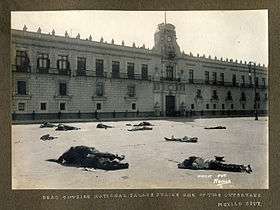
The Madero presidency was unraveling, to no one's surprise except perhaps Madero's, whose support continued to deteriorate, even among his political allies. Madero's supporters in congress before the coup, the so-called "Renovadores" ("the renewers"), criticized him, saying, "The revolution is heading toward collapse and is pulling the government to which it gave rise down with it, for the simple reason that it is not governing with revolutionaries. Compromises and concessions to the supporters of the old [Díaz] regime are the main causes of the unsettling situation in which the government that emerged from the revolution finds itself . . . The regime appears relentlessly bent on suicide."[86]
Huerta, formally in charge of the defense of Madero's regime, allowed the rebels to hold the armory in Mexico City--the Ciudadela--while he consolidated his political power. He changed allegiance from Madero to the rebels under Félix Díaz (Bernardo Reyes having been killed on the first day of the open armed conflict). U.S. Ambassador Henry Lane Wilson, who had done all he could to undermine U.S. confidence in Madero's presidency, brokered the Pact of the Embassy, which formalized the alliance between Félix Díaz and Huerta, with the backing of the United States.[87] Huerta was to become provisional president following the resignations of Madero and his vice president, José María Pino Suárez. Rather than being sent into exile with their families, the two were murdered while being transported to prison--a shocking event, but one that did not prevent the Huerta regime's recognition by most world governments.
Historian Friedrich Katz considers Madero's retention of the Federal Army, which was defeated by the revolutionary forces and resulted in Díaz's resignation, "was the basic cause of his fall." His failure is also attributable to "the failure of the social class to which he belonged and whose interests he considered to be identical to those of Mexico: the liberal hacendados [owners of large estates].[88] Madero had created no political organization that could survive his death and had alienated and demobilized the revolutionary fighters who had helped bring him to power. In the aftermath of his assassination and Huerta's seizure of power via military coup, former revolutionaries had no formal organization through which to raise opposition to Huerta.[89]
Huerta Regime, Feb. 1913–July 1914 and civil war
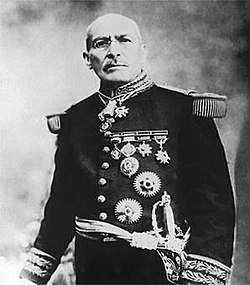
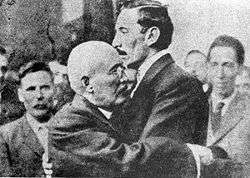
Huerta's presidency is usually characterized as a dictatorship. From the point of view of revolutionaries at the time and the construction of historical memory of the Revolution, it is without any positive aspects. "Despite recent attempts to portray Victoriano Huerta as a reformer, there is little question that he was a self-serving dictator."[90] There are few biographies of Huerta, but one strongly asserts that Huerta should not be labeled simply as a counter-revolutionary,[91] arguing that his regime consisted of two distinct periods: from the coup in February 1913 up to October 1913. During that time he attempted to legitimize his regime and demonstrate its legality by pursuing reformist policies; and after October 1913, when he dropped all attempts to rule within a legal framework and began murdering political opponents while battling revolutionary forces that had united in opposition to his regime.[92]
Supporting the Huerta regime initially were business interests in Mexico, both foreign and domestic; landed elites; the Roman Catholic Church; as well as the German and British governments. The United States President Woodrow Wilson, did not recognize the Huerta regime.[93] Huerta and Venustiano Carranza were in contact for two weeks immediately after the coup, but they did not come to an agreement. Carranza then declared himself opposed to Huerta and became the leader of the anti-Huerta forces in the north.[94] Huerta gained the support of revolutionary general Pascual Orozco, who had helped topple the Diaz regime, then became disillusioned with Madero. Huerta's first cabinet was comprised of men who had supported the February 1913 Pact of the [U.S.] Embassy, among them some who had supported Madero, such as Jesús Flores Magón; supporters of General Bernardo Reyes; supporters of Félix Díaz; and former Interim President Francisco León de la Barra.[95]
During the counter-revolutionary regime of Huerta (1913–1914), the Catholic Church initially supported him. "The Church represented a force for reaction, especially in the countryside."[71] However, when Huerta cracked down on political parties and conservative opposition, he had "Gabriel Somellera, president of the [National] Catholic Party arrested; La Nación, which, like other Catholic papers, had protested Congress's dissolution and the rigged elections [of October 1913], locked horns with the official press and was finally closed down. El País, the main Catholic newspaper, survived for a time."[96]
Initially, Huerta was even able to muster the support of Andrés Molina Enríquez, author of The Great National Problems (Los grandes problemas nacionales), a key work urging land reform in Mexico.[97] Huerta was deeply concerned with the issue of land reform, since it was a persistent spur of peasant unrest. Specifically, he moved to restore "ejido lands to the Yaquis and Mayos of Sonora and [advanced] proposals for distribution of government lands to small-scale farmers."[98][99] When Huerta refused to move faster on land reform, Molina Enríquez disavowed the regime in June 1913,[100] later going on to advise the 1917 constitutional convention on land reform.
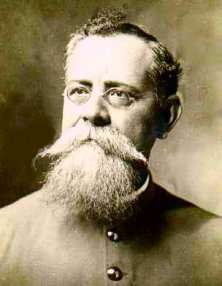
Within a month of the coup, rebellion began to spread throughout Mexico, most prominently led by the governor of the state of Coahuila, Venustiano Carranza, along with Pablo González and old revolutionaries demobilized by Madero, such as Pancho Villa. Carranza issued a narrowly political statement, the Plan of Guadalupe. Upon taking power, Huerta had moved swiftly to consolidate his hold in the North. Carranza might have counted on Chihuahua Gov. Abraham González, but Huerta had him arrested and murdered for fear he would foment rebellion.[89] The Northern revolutionaries fought under the name of the Constitutionalist Army, with Carranza as the "First Chief" (primer jefe). When northern General Pancho Villa became governor of Chihuahua in 1914, following the ousting of Huerta, he located González's bones and had them reburied with full honors.
In Morelos, Emiliano Zapata continued his rebellion under the Plan of Ayala (while expunging the name of counter-revolutionary Pascual Orozco from it), calling for the expropriation of land and redistribution to peasants. Huerta offered peace to Zapata, who rejected it.[101] The Huerta government was thus challenged by revolutionary forces in the north of Mexico and in the strategic state of Morelos, just south of the capital.
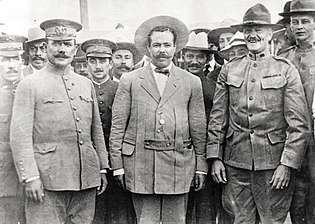
Lame duck U.S. President William Howard Taft, whose term ended 4 March 1913, left the decision of whether to recognize the new government up to the incoming president, Woodrow Wilson. Despite the urging of U.S. ambassador Henry Lane Wilson, who had played a key role in the coup d'état, President Wilson not only declined to recognize Huerta's government but first supplanted the ambassador by sending his "personal representative" John Lind, a Swedish-American progressive who sympathized with the Mexican revolutionaries, and then, in the summer of 1913, the president recalled Ambasssador Wilson. Further, under President Wilson, the United States lifted the arms embargo imposed by Taft in order to supply weapons to the landlocked rebels; while under the complete embargo Huerta had still been able to receive shipments from the British.[102] While urging other European powers to likewise not recognize Huerta's government, Wilson also attempted to persuade Huerta to call prompt elections "and not present himself as a candidate."[103] The United States offered Mexico a loan on the condition that Huerta accept the proposal. He refused. Lind "clearly threatened a military intervention in case the demands were not met."[104]
In the summer of 1913 Mexican conservatives who had supported Huerta sought a constitutionally elected civilian alternative to Huerta, brought together in a body called the National Unifying Junta.[105] Political parties proliferated in this period, so that by the time of the October congressional elections there were 26. From Huerta's point of view, the fragmentation of the conservative political landscape strengthened his own position. For the country's conservative elite, "there was a growing disillusionment with Huerta, and disgust at his strong-arm methods."[106] Huerta dispensed with the legislature on 26 October 1913, having the army surround its building and arresting congressmen perceived to be hostile to his regime. Congressional elections went ahead, but given that congress was dissolved and some members were in jail, the fervor of opposition candidates disappeared. The sham election "brought home to [Woodrow] Wilson's administration the fatuity of relying on elections to demonstrate genuine democracy."[107] The October 1913 elections were the end of any pretension to constitutional rule in Mexico, with civilian political activity banned.[108] Prominent Catholics were arrested and Catholic newspapers were suppressed.[109]
Huerta militarized Mexico to a greater extent than it already was. In 1913 when Huerta seized power, the army had approximately 50,000 men, but Huerta mandated the number rise to 150,000, then 200,000 and, finally in spring 1914, 250,000.[110] Raising that number of men in so short a time would not occur with volunteers, and the army resorted to the leva, forced conscription. The revolutionary forces had no problem with voluntary recruitment.[111] Most Mexican men avoided government conscription at all costs and the ones dragooned into the forces were sent to areas far away from home and were reluctant to fight. Conscripts deserted, mutinied and attacked and murdered their officers.[112]
In April 1914 U.S. opposition to Huerta culminated in the seizure and occupation of the port of Veracruz by U.S. marines and sailors. Initially intended, in part, to prevent a German merchant vessel from delivering a shipment of arms to the Huerta regime, the muddled operation evolved into a seven-month stalemate resulting in the death of 193 Mexican soldiers, 19 U.S. servicemen and an unknown number of civilians. The German ship landed its cargo--largely U.S.-made rifles--in a deal brokered by U.S. businessmen (at a different port). U.S. forces eventually left Veracruz in the hands of the Carrancistas, but with lasting damage to U.S.-Mexican relations.[113][114][115]
Huerta's position continued to deteriorate. In mid-July 1914, after his army suffered several defeats, he stepped down and fled to Puerto México. Seeking to get himself and his family out of Mexico, he turned to the German government, which had generally supported his presidency. The Germans were not eager to allow him to be transported into exile on one of their ships, but relented. Huerta carried "roughly half a million marks in gold with him" as well as paper currency and checks.[116] In exile, Huerta sought to return to Mexico via the United States; U.S. authorities arrested him and he was imprisoned in Fort Bliss, Texas. He died in January 1916, six months after going into exile.[117]
Huerta's resignation marked the end of an era since the Federal Army, a spectacularly ineffective fighting force against the revolutionaries, ceased to exist.[118] The revolutionary factions that had united in opposition to Huerta's regime now faced a new political landscape with the counter-revolutionaries decisively defeated. The revolutionary armies now contended for power and a new era of civil war began after an attempt at an agreement among the winners at a Convention of Aguascalientes.
Meeting of the Winners, then civil war 1914–1915
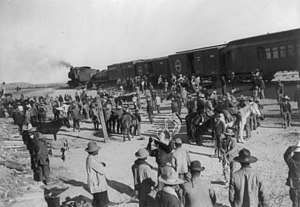
With the departure of Huerta in July 1914, the revolutionary factions agreed to meet and make "a last-ditch effort to avert more intense warfare than that which unseated Huerta."[119] Called to meet in Mexico City in October 1914, revolutionaries opposed to Carranza's influence successfully moved the venue to Aguascalientes. The Convention of Aguascalientes did not, in fact, reconcile the various victorious factions in the Mexican Revolution. The break between Carranza and Villa became definitive during the Convention. "Carranza spurned it, and Villa effectively hijacked it. Mexico's lesser caudillos were forced to choose" between those two forces.[120] It was a brief pause in revolutionary violence before another all-out period of civil war ensued.
Carranza had expected to be confirmed in his position as First Chief of revolutionary forces, but his supporters "lost control of the proceedings."[121] Opposition to Carranza was strongest in areas where there were popular and fierce demands for reform, particularly in Chihuahua where Villa was powerful, and Morelos where Zapata held sway.[122] The Convention of Aguascalientes brought that opposition out in an open forum.
The revolutionary generals of the Convention called on Carranza to resign executive power. Although he agreed to do so, he laid out conditions for it. He would resign if both Pancho Villa and Emiliano Zapata, his main rivals for power, would resign and go into exile, and that there should be a pre-constitutionalist government "that would take charge of carrying out the social and political reforms the country needs before a fully constitutional government is re-established."[123]
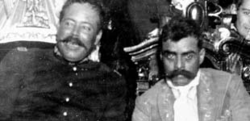
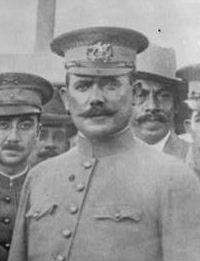
Rather than First Chief Carranza being named president of Mexico at the convention, General Eulalio Gutiérrez was chosen for a term of 20 days. The convention declared Carranza in rebellion against it. Civil war resumed, this time between revolutionary armies that had fought in a united cause to oust Huerta in 1913–14. Although during the Convention Constitutionalist General Alvaro Obregón had attempted to be a moderating force and had been the one to convey the Convention's call for Carranza to resign, when the convention forces declared Carranza in rebellion against it, Obregón supported Carranza rather than Villa and Zapata.
Villa went into a loose alliance with southern leader Zapata to form the Army of the Convention. Their forces moved separately on the capital, Mexico City, and took it--which Carranza's forces had abandoned--in December 1914. The famous picture of Zapata and Villa, with Villa sitting in the presidential chair in the National Palace, is a classic image of the Revolution. Villa is reported to have said to Zapata that the presidential chair "is too big for us."[124]
In practice, the alliance between Villa and Zapata as the Army of the Convention did not function beyond this initial victory against the Constitutionalists. Villa and Zapata left the capital, with Zapata returning to his southern stronghold in Morelos, where he continued to engage in warfare under the Plan of Ayala.[125] Lacking a firm center of power and leadership, the Convention government was plagued by instability. Villa was the real power emerging from the Convention, and he prepared to strengthen his position by winning a decisive victory against the Constitutionalist Army.
Villa had a well-earned reputation as a fierce and successful general, and the combination of forces arrayed against Carranza by Villa, other northern generals and Zapata was larger than the Constitutionalist Army, so it was not at all clear that Carranza would prevail. He had the advantage of the loyalty of General Alvaro Obregón. Despite Obregón's moderating actions at the Convention of Aguascalientes, even trying to persuade Carranza to resign his position, he ultimately sided with Carranza.[126]
Another advantage of Carranza's position was the Constitutionalists' control of Veracruz, even though the United States still occupied it. The United States had concluded that both Villa and Zapata were too radical and hostile to its interests and sided with the moderate Carranza in the factional fighting.[127] The U.S. timed its exit from Veracruz, brokered at the Niagara Falls peace conference, to benefit Carranza and allowed munitions to flow to the Constitutionalists. The U.S. granted Carranza's government diplomatic recognition in October 1915.
The rival armies of Villa and Obregón clashed in April 1915 in the Battle of Celaya, which lasted from the sixth to the 15th. The frontal cavalry charges of Villa's forces were met by the shrewd, modern military tactics of Obregón. The victory of the Constitutionalists was complete, and Carranza emerged as the political leader of Mexico with a victorious army to keep him in that position. Villa retreated north. Carranza and the Constitutionalists consolidated their position as the winning faction, with Zapata remaining a threat until his assassination in 1919. Villa also remained a threat to the Constitutionalists, complicating their relationship with the United States when elements of Villa's forces raided Columbus, New Mexico, in March 1916, prompting the U.S. to launch a punitive expedition into Mexico in an unsuccessful attempt to capture him.
Constitutionalists in Power under Carranza, 1915–1920
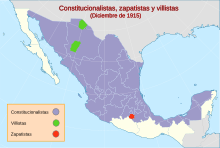
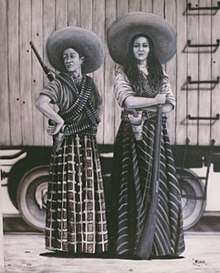
Venustiano Carranza had proclaimed the Plan of Guadalupe a month after Victoriano Huerta seized power in February 1913, uniting northern factions into a movement to oust Huerta, especially under generals Alvaro Obregón and Pancho Villa. Huerta went into exile in July 1914 and the revolutionary factions sought to decide Mexico's political future in the Convention of Aguascalientes. Villa broke with Carranza and went into alliance with Emiliano Zapata. General Obregón remained loyal to Carranza and led the Constitutionalist Army to victory over Villa in the Battle of Celaya in April 1915.
The decisive defeat by Obregón of the Constitutionalists' main rival Pancho Villa in a series of battles in 1915 ended the most serious threat from the north. The U.S. recognized Carranza's government as the de facto ruling power in October 1915, following those military victories. This gave Carranza's Constitutionalists legitimacy internationally and access to arms from the U.S. The Carranza government still had active opponents, including Villa, who retreated north,[128] and Zapata, who remained active in the south. Even though he was losing support, Zapata remained a threat to the Carranza regime until his assassination by order of Carranza on 10 April 1919.[129]
The Constitutionalist Army was renamed the "Mexican National Army" and Carranza sent some of its most able generals to eliminate threats. In Morelos he sent General Pablo González Garza to fight Zapata's Liberating Army of the South.[130] Although the peasants of Morelos under Zapata had not expanded beyond their local region and parts of the state of Puebla, Carranza sought to eliminate Zapata. Morelos was very close to Mexico City, and not having it under Carranza's control constituted a vulnerability for his government. Agents of the Carranza regime assassinated Zapata in 1919. Carranza sent General Francisco Murguía and General Manuel M. Diéguez to track down and eliminate Villa. They were unsuccessful, but did capture and execute one of Villa's top men, Felipe Angeles.[131]
Carranza pushed for the rights of women and gained women's support. During his presidency he relied on his personal secretary and close aide, Hermila Galindo de Topete, to rally and secure support for him. Through her efforts he was able to gain the support of women, workers and peasants. Carranza rewarded her efforts by lobbying for women's equlity. He helped change and reform the legal status of women in Mexico.[132]
Venustiano Carranza did not move on land reform despite the provisions in the new constitution providing for it. Rather, he returned confiscated estates to their owners.[133] Not only did he oppose large-scale land reform, he vetoed laws that would have increased agricultural production by giving peasants temporary access to lands not under cultivation.[134] In places where peasants had fought for land reform, Carranza's policy was to repress them and deny their demands. In the southeast, where hacienda owners held strong, Carranza sent the most radical of his supporters, Francisco Múgica in Tabasco and Salvador Alvarado in Yucatan, to mobilize peasants and be a counterweight to the hacienda owners.[135] Salvador Alvarado after taking control of Yucatán in 1915, organized a large Socialist Party and carried out extensive land reform. He confiscated the large landed estates and redistributed the land in smaller plots to the liberated peasants.[136] Maximo Castillo, a revolutionary brigadier general from Chihuahua was annoyed by the slow pace of land reform under the Madero presidency. He ordered the subdivision of six haciendas belonging to Luis Terrazas, which were given to sharecroppers and tenants.[137]
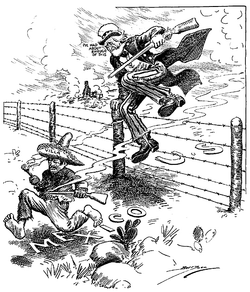
Carranza's relationship with the United States had initially benefited from its recognition of his government, with the Constitutionalist Army being able to buy arms. In 1915 and early 1916, there is evidence that Carranza was seeking a loan from the U.S. with the backing of U.S. bankers and a formal alliance with the U.S. Mexican nationalists in Mexico were seeking a stronger stance against the colossus of the north, taxing foreign holdings and limiting their influence. With Villa's raid against Columbus, New Mexico in March 1916, ended the possibility of a closer relationship with the U.S.[138] Under heavy pressure from American public opinion to punish the attackers (stoked mainly by the papers of ultra-conservative publisher William Randolph Hearst, who owned a large estate in Mexico), U.S. President Woodrow Wilson sent General John J. Pershing and around 5,000 troops into Mexico in an attempt to capture Villa.[139] The American intervention, known as the Punitive Expedition, was limited to the western Sierras of Chihuahua and was notable as the U.S. Army's first use of airplanes in military operations. Villa knew the inhospitable terrain intimately and had little trouble evading his pursuers. Villa was deeply entrenched in the mountains of northern Mexico, and knew the terrain too well to be captured. Pershing could not continue with his mission and was forced to turn back. This event not only damaged the fragile United States-Mexico relationship, but also gave way to a rise in anti-American sentiment among the Mexicans.[140]After nearly a year the hunt was called off, and Pershing's force returned to the U.S. Carranza asserted Mexican sovereignty and forced the U.S. to withdraw in 1917.
With the outbreak of World War I in Europe in 1914, foreign powers with significant economic and strategic interests in Mexico--particularly the U.S., Great Britain and Germany--made efforts to sway Mexico to their side, but Mexico maintained a policy of neutrality. In the Zimmermann Telegram--a coded cable from the German government to Carranza's government--Germany attempted to draw Mexico into war with the United States, which was itself neutral at the time. Carranza did not pursue this policy, but the leaking of the telegram pushed the U.S. into war against Germany in 1917.
The 1917 Constitution, and the last successful coup
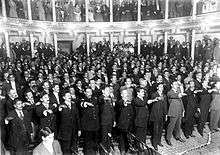
Carranza's 1913 Plan of Guadalupe was narrowly political, but he sought to consolidate his position with support of the masses by policies of social and agrarian reform. As revolutionary violence subsided in 1916, leaders met to draw up a new constitution, thus making principles for which many of the revolutionaries had fought into law. The Mexican Constitution of 1917 was strongly nationalist, giving the government the power to expropriate foreign ownership of resources and enabling land reform (Article 27). It also had a strong code protecting organized labor (Article 123) and extended state power over the Roman Catholic Church in Mexico in its role in education (Article 3).
Although villistas and zapatistas were excluded from the Constituent Congress, their political challenge pushed the delegates to radicalize the Constitution, which in turn was far more radical than Carranza himself.[19] While he was elected constitutional president in 1917, he did not implement its most radical elements. He was not in a position to do so in any case, since there were still threats to his regime regionally, despite the relative subsiding of violence nationally.
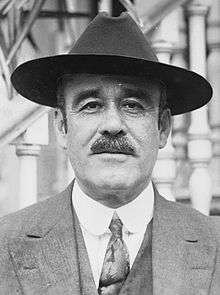
Carranza had consolidated enough power to go forward with the drafting of a new constitution in 1917. Carranza was acting president and called for a constituent congress to draft a new document based on liberal and revolutionary principles. Labor had supported the Constitutionalists and Red Battalions had fought against the Zapatistas. Radical reforms were embedded in the constitution, in particular labor rights, agrarian reform, anticlericalism, and economic nationalism. The Mexican state asserted dominion over the nation's territory and resources (Article 27), which enabled land reform and expropriation of Labor was rewarded with a strong article in the 1917 constitution protecting labor rights (Article 123). Following the ratification of the constitution, Carranza was elected to the presidency of Mexico.[141]
After all the bloodshed of the revolution concerning the principle of "no re-election", it was politically impossible for Carranza to run again in the election due to be held in 1920. He chose to back Ignacio Bonillas, a civilian and political unknown. For Northern generals Alvaro Obregón, Plutarco Elías Calles and Adolfo de la Huerta, who had fought successfully for the revolution, the candidacy of a civilian and potential Carranza puppet was untenable. They led a revolt against Carranza under the Plan of Agua Prieta. Carranza attempted to flee the country and died on the way to the Gulf Coast.
Prior to the elections, General Obregón had returned to Sonora and became a political threat to the civilian Carranza. The Regional Confederation of Mexican Workers (CROM) supported Obregón. Carranza was increasingly unpopular, with his minimal implementation of land reform and his return of confiscated haciendas in the north to their owners alienated peasants seeking land. He crushed a strike of workers in Mexico City, alienating labor. Even as his political authority was waning, Carranza attempted to impose a political nobody, Mexico's ambassador to the U.S., Ignacio Bonillas, as his successor. Under the Plan of Agua Prieta, a triumvirate of Sonoran generals, Alvaro Obregón, Plutarco Elías Calles, and Adolfo de la Huerta, with elements from the military and labor supporters in the CROM, rose in successful rebellion against Carranza, the last successful coup of the revolution.[142] Carranza fled to Guerrero but was killed or committed suicide fleeing from Mexico City to Veracruz.[143] Carranza's attempt to impose his choice was considered a betrayal of the Revolution and his remains were not placed in the Monument to the Revolution until 1942.[144]
"Obregón and the Sonorans, the architects of Carranza's rise and fall, shared his hard headed opportunism, but they displayed a better grasp of the mechanisms of popular mobilization, allied to social reform, that would form the bases of a durable revolutionary regime after 1920."[145] The interim government of Adolfo de la Huerta negotiated Pancho Villa's surrender in 1920, rewarding him with an hacienda where he lived in peace until he floated political interest in 1924 election. Villa was assassinated in July 1923.[146] Alvaro Obregón was elected president in October 1920, the first of a string of revolutionary generals -- Calles, Rodríguez, Cárdenas, and Avila Camacho—to hold the presidency until 1946, when Miguel Alemán, the son of a revolutionary general, was elected.
Emiliano Zapata and the Revolution in Morelos

From the late Porfiriato until his assassination by an agent of President Carranza in 1919, Emiliano Zapata played an important role in the Mexican Revolution, since his home territory in Morelos was of strategic importance. Of the revolutionary factions, it was the most homogeneous, with most being free peasants and only few peons on haciendas. With no industry to speak of in Morelos, there were no industrial workers in the movement and no middle class participants. Some intellectuals supported the Zapatistas. The Zapatistas' armed opposition movement just south of the capital needed to be heeded. Unlike northern Mexico, close to the U.S. border, the Zapatista territory in Morelos did not have access to arms, nor did it play into international politics. The Zapatistas were divided into guerrilla fighting forces that joined together for major battles before returning to their home villages. Zapata was not a peasant himself, but led peasants in his home state of Morelos in regionally concentrated warfare regain village lands and return to subsistence agriculture. Morelos was the only region where land reform was enacted during the years of fighting.[148] He initially supported Madero, but during the Interim Presidency of De la Barra, attacks by government forces drove a wedge between the Madero and Zapata. Madero's failure to move on land reform during 1911-13 was a key reason the Zapata rebelled against him under the Plan of Ayala (1911).[149][150] With the overthrow of Madero in the Ten Tragic Days, Zapata disavowed his previous admiration of revolutionary general Pascual Orozco and directed warfare against the Huerta government. With the defeat of Huerta in July 1914, Zapata loosely allied with Pancho Villa, previously allied with Venustiano Carranza and the Constitutionalist Army, particularly General Alvaro Obregón. The Zapata-Villa alliance lasted until Obregón decisively defeated Villa in a series of battles, including the Battle of Celaya. Zapata continued to oppose the Constitutionalists, but lost support in his own area and attempted to entice defectors to his movement. That was a fatal error. He was ambushed and killed on 10 April 1919 by agents of Venustiano Carranza, General Pablo González and his aide, Col. Jesús Guajardo, in an elaborate trap at Chinameca, Morelos. Guajardo set up the meeting under the pretext of wanting to defect to Zapata's side from Carranza's. At the meeting, González's men assassinated Zapata.[151] Photos were taken of his corpse, demonstrating that he had been killed.
Although Zapata was assassinated, the agrarian reforms that were enacted in Morelos were impossible to reverse. The central government came to terms with that state of affairs. Zapata had fought for land for the tillers in Morelos, and succeeded. His credentials as a steadfast revolutionary made him an enduring hero of the Revolution. His name and image were invoked in the 1994 uprising in Chiapas, with the Zapatista Army of National Liberation.
Consolidation of the Revolution, 1920–1940

One of the major issues that faced Alvaro Obregón's early post-revolution government was stabilizing Mexico. Regional caciques (chiefs) were still fighting each other in small skirmishes. The populace was demanding reforms, promised by the 1917 constitution. Many issues faced the working poor, such as debt peonage and company stores that kept the populace poor. The military had generals who wanted to overthrow the regime and take power for themselves. There were also foreign governments, primarily the United States, who feared Mexico would take a communist turn such as Russia was to do in 1918. Obregón was in a difficult position; he had to appeal to both the left and the right to ensure Mexico would not fall back into civil war. With regard to the masses, Obregón, who was conservative but still a reformer, started listening to demands to appease the populace. Obregón's first focus, in 1920, was land reform. He had governors in various states push forward the reforms promised in the 1917 constitution. These were, however, quite limited. Former Zapatistas still had strong influence in the post-revolutionary government, so most of the reforms began in Morelos, the birthplace of the Zapatista movement.[152]
Despite pressures from the U.S., Obregón flirted with the newly formed USSR. To appeal to intellectuals and left-leaning peasants, official Mexican propaganda began having a very Marxist spin. Murals with Lenin and Trotsky began to appear in government buildings. The government also began to foment nationalism amongst the peasantry. This was accomplished by memorializing revolutionary figures and creating anti-Western murals. Among the artists employed was Diego Rivera, who had a Mexican nationalist and Marxist tinge to his government murals. Despite these moves towards an anti-Western and pro-socialist regime, Obregón did not separate the Mexican economy from foreign capitalists, allowing free trade with some restrictions.
Regarding the military, one of his first moves was to incorporate the irregulars who fought in the revolution. He tried to weaken the powers of the ultra-conservative officer corps, who were not friendly to his regime. Some of his reforms began to anger the officer corps, leading to an attempted coup in 1924 that Obregón was able to crush with relative ease.
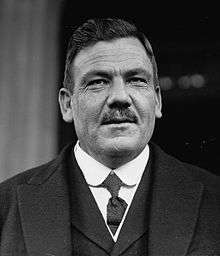
Shortly after the failed coup, Obregón's term ended and Sonoran revolutionary Plutarco Elías Calles took power. In an attempt to buffer his regime against further coups, Calles began arming peasants and factory workers with surplus weapons. He continued other reforms pushed by his predecessor, such as land reform and anti-clerical laws to prevent the Catholic Church from influencing the state. One such move, in regard to land reform, was to nationalize most farmland and give it to the peasants across Mexico. He also put into effect a national school system that was largely secular to combat church influence in late 1924. After two years the church protested the movement by refusing to give the blessed sacrament to the populace. Some peasants also joined in the protests, adding greater land reforms to the list of demands by the rebelling priests. The rebellion was openly supported by the Catholic Church and received funding, beginning the Cristero War.[153]
Meanwhile, in 1927, another military coup was attempted, this time receiving support from land owners. Calles quickly crushed the rebellion with help from the newly mobilized peasant battalions, who later on were used to fight against the Church. In the midst of the mobilized worker's militias, land reform, and anti-church actions, the American government began to openly declare Mexico a Bolshevik regime. To recover from the backlash, Calles began to tone down the radical rhetoric and slowed land reform policies in 1928. A year later, a brokered ceasefire was issued to end hostilities.
After the war ended in 1929, supporters of Calles and Obregón began to form a united political party called the National Revolutionary Party (PNR). This was to unite the various revolutionary factions of the civil war to prevent further Cristero revolts and build stability.
After a series of interim presidents controlled by the party, Lázaro Cárdenas took power in 1934. Cárdenas was a socialist and began to base government policy on class struggle and empowering the masses. However, not all of his reforms were completely socialist. Regardless, his rule was the most radical phase of social reform following the revolution.
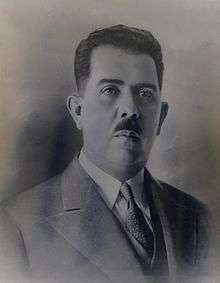
His first acts of reform in 1935, were aimed towards peasants. Former strongmen within the land owning community were losing political power, so he began to side with the peasants more and more. He also tried to further centralize the government's power by removing regional caciques, allowing him to push reforms easier. To fill the political vacuum, Cárdenas helped the formation of PNR sponsored peasant leagues, empowering both peasants and the government. Other reforms included nationalization of key industries such as petroleum, land, and the railroads. To appease workers, Cárdenas furthered provisions to end debt peonage and company stores, which were largely eliminated under his rule, except in the most backwater areas of Mexico. To prevent conservative factions in the military from plotting and to put idle soldiers to work, Cárdenas mobilized the military to build public works projects. That same year another Cristero revolt occurred. This was partially caused by Cárdenas' mandate for secular education early in his presidency in 1934. The revolt was quickly put down due to lack of official support from the Catholic Church, who told rebels to surrender themselves to the government.[154]
The next year, 1936, to further stabilize his rule, Cárdenas further armed the peasants and workers and begins to organize them into formal militias. This proved to be useful later in his presidency as the militias came to his aid in the final military coup in revolutionary Mexico in 1938. Seeing no opposition from the bourgeoisie, generals, or conservative landlords, in 1936 Cárdenas began building collective farms called ejidos to help the peasantry, mostly in southern Mexico. These appeased the peasants, creating long-lasting stability; however, they were not very good at feeding large populations, causing an urban food crisis. To alleviate this, Cárdenas co-opted the support of capitalists to build large commercial farms to feed the urban population. This put the final nail in the coffin of the feudal hacienda system, making Mexico a mixed economy, combining agrarian socialism and industrial capitalism by 1940. Cárdenas left office in 1940, marking the end of the social revolution and ushering in half a century of relative stability.[155]
Cultural aspects of the Mexican Revolution
There was considerable cultural production during the Revolution itself, including printmaking, music and photography, while in the postrevolutionary era, revolutionary themes in painting and literature shaped historical memory and understanding of the Revolution.
Painting
The government of Alvaro Obregón (1920-24) and his Minister of Education, José Vasconcelos commissioned artists to decorate government buildings of the colonial era with murals depicting Mexico's history. Many of these focused on aspects of the Revolution. The "Big Three" of Mexican muralism, Diego Rivera, José Clemente Orozco, and David Alfaro Siqueiros produced narratives of the Revolution, shaping historical memory and interpretation.[156][157]
Prints and cartoons
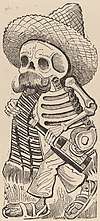
During the late Porfiriato, political cartooning and print making developed as popular forms of art. The most well known print maker of that period is José Guadalupe Posada, whose satirical prints, particularly featuring skeletons, circulated widely.[158] Posada died in early 1913, so his caricatures are only of the early revolution. One published in El Vale Panchito entitled "oratory and music" shows Madero atop a pile of papers and the Plan of San Luis Potosí, haranguing a dark-skinned Mexican whose large sombrero has the label pueblo (people). Madero is in a dapper suit. The caption reads "offerings to the people to rise to the presidency."[159] Political cartoons by Mexicans as well as Americans caricatured the situation in Mexico for a mass readership.[160] Political broadsides including songs of the revolutionary period were also a popular form of visual art. After 1920, Mexican muralism and printmaking were two major forms of revolutionary art. Prints were easily reproducible and circulated widely, while murals commissioned by the Mexican government necessitated a journey to view them. Printmaking "emerged as a favored medium, alongside government sponsored mural painting among artists ready to do battle for a new aesthetic as well as a new political order."[161] Diego Rivera , better known for his painting than printmaking, reproduced his depiction of Zapata in the murals in the Cortés Palace in Cuernavaca in a 1932 print.[162]
Photography and motion pictures
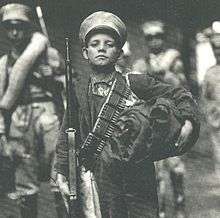
The Mexican Revolution was extensively photographed as well as filmed, so that there is a large, contemporaneous visual record. "The Mexican Revolution and photography were intertwined."[165] There was a large foreign viewership for still and moving images of the Revolution. The photographic record is by no means complete since much of the violence took place in relatively remote places, but it was a media event covered by photographers, photojournalists, and professional cinematographers. Those behind the lens were hampered by the large, heavy cameras that impeded capturing action images, but no longer was written text enough, with photographs illustrating and verifying the written word.
The Revolution "depended heavily, from its inception, on visual representations and, in particular, on photographs."[166] The large number of Mexican and foreign photographers followed the action and stoked public interest in it. Among the foreign photographers were Jimmy Hare, Otis A. Aultman, Homer Scott, and Walter Horne. Images appeared in newspapers and magazines, as well as postcards.[167] Horne was associated with the Mexican War Postcard Company.[168]
Most prominent of the documentary film makers were Salvador Toscano and Jesús H. Abitía, and some 80 cameramen from the U.S. filmed as freelancers or employed by film companies. The footage has been edited and reconstructed into documentary films, Memories of a Mexican (Carmen Toscano de Moreno 1950) and Epics of the Mexican Revolution (Gustavo Carrera).[169] Principal leaders of the Revolution were well aware of the propaganda element of documentary film making, and Pancho Villa contracted with an American film company to record for viewers in the U.S. his leadership on the battlefield. The film has been lost, but the story of the film making was interpreted in the HBO scripted film And Starring Pancho Villa as Himself. [170] The largest collection of still photographs of the Revolution is the Casasola Archive, named for photographer Agustín Casasola (1874-1938), with nearly 500,000 images held by the Fototeca Nacional in Pachuca.
Music

A number of traditional Mexican songs or corridos were written at the time and memorialize aspects of the Mexican Revolution. [171][172] The term for soldaderas, known as Adelitas is from a corrido of the same name. The song, La Cucaracha, with numerous verses, was also popular at the time of the Revolution and subsequently. Published corridos often had images of particular revolutionary heroes along with the verses. One that remains popular today is La Cucaracha.
Literature
There were few novels of the Mexican Revolution written at the time, most notably Mariano Azuela's Los de Abajo (translated as The Underdogs) is a notable one, originally published in serial form in newspapers. Literature is a lens through which to see the Revolution.[173] Nellie Campobello is one of the few women writers of the Revolution, publishing Cartucho (1931). It is an account of the Revolution in northern Mexico, emphasizing the role of Villistas, when official discourse was erasing Villa's memory and emphasizing nationalist and centralized ideas of the Revolution.[174] Martín Luis Guzmán's El águila y el serpiente (1928) and La sombra del caudillo(1929) drew on his experiences in the Constitutionalist Army.[175][176] In the fiction of Carlos Fuentes, particularly The Death of Artemio Cruz, the Revolution and its perceived betrayal, is a key factor in driving the narrative.
Historical Memory

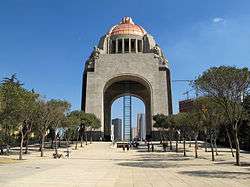
The centennial of the Mexican Revolution was another occasion to construct of historical of the events and leaders. In 2010, the Centennial of the Revolution and the Bicentennial of Independence was an occasion to take account of Mexico's history. The centennial of independence in 1910 had been the swan song of the Porfiriato. With President Felipe Calderón (2006-2012) of the conservative National Action Party, there was considerable emphasis on the bicentennial of independence rather than on the Mexican Revolution.
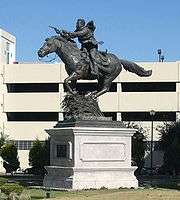
The most permanent manifestations of historical are in the built landscape, especially the Monument to the Revolution in Mexico City and statues and monuments to particular leaders. The Monument to the Revolution was created from the partially built Palacio Legislativo, a major project of Díaz's government. The construction was abandoned with the outbreak of the Revolution in 1910. In 1933 during the Maximato of Plutarco Elías Calles the shell was re-purposed to commemorate the Revolution. Buried in the four pillars are the remains of Francisco I. Madero, Venustiano Carranza, Plutarco Elías Calles, Lázaro Cárdenas, and Francisco [Pancho] Villa.[177] In life, Villa fought Carranza and Calles, but his remains were transferred to the monument in 1979 during the administration of President José López Portillo.[178] Prior to the construction of that monument, one was built in 1935 to the amputated arm of General Álvaro Obregón, lost in victorious battle against Villa in the 1915 Battle of Celaya. The monument is on the site of the restaurant La Bombilla, where he was assassinated in 1928. The arm was cremated in 1989, but the monument remains.[179][180]
Emiliano Zapata is buried in Cuautla, Morelos, near where he was assassinated in 1919. Since 1920 yearly ceremonies commemorate his assassination at his grave. In 1923, as president of Mexico, Álvaro Obregón sent an envoy to the ceremony in Cuautla and paid the expenses of other officials from the capital to attend.[181]
Names of towns and neighborhoods of major cities. Mexican banknotes also commemorate Mexican revolutionaries, most prominently Plutarco Elías Calles, revolutionary general, president of Mexico, and founder of the political party that has dominated Mexico almost continuously from 1919. Lázaro Cárdenas, revolutionary general and president of Mexico, who is often credited with revitalizing the Revolution, is commemorated on a banknote. In 1996, low denomination Mexican peso notes were printed with the image of peasant revolutionary Emiliano Zapata. The banknotes were withdrawn in 1997.[182] The obverse of the withdrawn banknote depicted the Zapata statue erected in Cuautla in 1932 by Oliverio Martínez showing Zapata in full charro attire seated on a fine horse, placing his hand on the shoulder of a peasant with a machete.[183]
The Mexico City Metro has stations commemorating aspects of the Revolution and the revolutionary era. When it opened in 1969, with line 1 (the "Pink Line"), two stations alluded to the Revolution. Most directly referencing the Revolution was Metro Pino Suárez, named after Francisco I. Madero's vice president, who was murdered with him in February 1913. The other was Metro Balderas, whose icon is a cannon, alluding to the Ciudadela armory where the coup against Madero was launched. In 1970, Metro Revolución opened, with the station at the Monument to the Revolution. As the Metro expanded, further stations with names from the revolutionary era opened. In 1980, two popular heroes of the Revolution were honored, with Metro Zapata explicitly commemorating the peasant revolutionary from Morelos. A sideways commemoration was Metro División del Norte, named after the Army that Pancho Villa commanded until its demise in the Battle of Celaya in 1915. The year 1997 saw the opening of the Metro Lázaro Cárdenas station. In 1988, Metro Aquiles Serdán honors the first martyr of the Revolution Aquiles Serdán. In 1994, Metro Constitución de 1917 opened, as did Metro Garibaldi, named after the grandson of Italian fighter for independence, Giuseppi Garibaldi. The grandson had been a participant in the Mexican Revolution. In 1999, the radical anarchist Ricardo Flores Magón was honored with the Metro Ricardo Flores Magón station. Also opening in 1999 was Metro Romero Rubio, named after the leader of Porfirio Díaz's Científicos, whose daughter Carmen Romero Rubio became Díaz's second wife.[184] In 2012, a new Metro line opened with a Metro Hospital 20 de Noviembre stop, a hospital named after the date that Francisco I. Madero in his 1910 Plan de San Luis Potosí, called for rebellion against Díaz. There is no Metro stop named for Madero, or for Carranza, Obregón, or Calles, and only an oblique reference to Villa in Metro División del Norte.
In Mexico City, there are delegaciones (boroughs) named for Alvaro Obregón, Venustiano Carranza, and Gustavo A. Madero, brother of murdered president Francisco I. Madero. There is a portion of the old colonial street Calle de los Plateros leading to the main square zócalo of the capital named Francisco I. Madero.
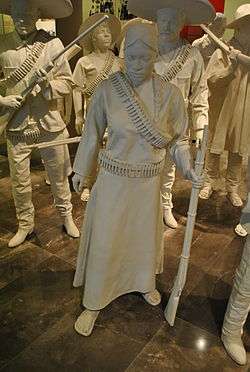
The popular heroes of the Mexican Revolution are the two radicals who lost: Emiliano Zapata and Pancho Villa.[19] Dynamic equestrian statues of popular revolutionaries Zapata and Villa were erected in their respective strongholds. Zapata's name was appropriated by the rebels of Chiapas, the Zapatista Army of National Liberation (EZLN) while those who took and held power have a far more muted historical remembrance. Venustiano Carranza led the victorious Constitutionalist faction, but his attempt to impose a civilian presidential successor unacceptable to northern revolutionary generals prompted Carranza's flight from Mexico City in 1920 and then murder. Carranza is now buried in the Monument to the Revolution and there is a museum in his honor. In that museum, "are the bullets taken from the body of Francisco I. Madero after his murder. Carranza had kept them in his home, perhaps because they were a symbol of a fate and a passive denouement he had always hoped to avoid."[185]
The role of women in the Mexican Revolution has been an important aspect of historical memory. In the Historical Museum of the Mexican Revolution, there is a recreation of Adelita, the idealized female revolutionary combatant or soldadera. The typical image of a soldadera is of a woman with braids, wearing female attire, with ammunition belts across her chest. There were a few revolutionary women, known as coronelas who commanded troops, some of whom dressed and identified as male, who do not fit the image stereotypical soldadera and are not celebrated in historical memory at present.[186]
Legacies
Strong central government
Although the ignominious end of Venustiano Carranza's presidency in 1920 cast a shadow over his legacy in the Revolution, sometimes viewed as a conservative revolutionary, he and his northern allies laid "the foundation of a more ambitious, centralizing state dedicated to national integration and national self-assertion."[120] In the assessment of historian Alan Knight, "a victory of Villa and Zapata would probably have resulted in a weak, fragmented state, a collage of revolutionary fiefs of varied political hues presided over by a feeble central government."[120] Porfirio Díaz had successfully centralized power during his long presidency. Carranza was an old politico of the Díaz regime, considered a kind of bridge between the old Porfirian order and the new revolutionary.[187] The northern generals seized power in 1920, with the "Sonoran hegemony prov[ing] complete and long lasting."[188] The Sonorans, particularly Alvaro Obregón, were battle-tested leaders and pragmatic politicians able to consolidate centralized power immediately after the military phase ended. The revolutionary struggle created a new regime that comprised the regional faction of northwest Mexico, willing to make deals with other regions and factions. In the assessment of historian John Womack, "The new state itself would therefore serve as the nation's bourgeois party. Its function forecast its programme, a long series of reforms from above... [from] threats to Mexican sovereignty and capitalism from abroad and from below."[189] The Constitution of 1917 gave the government tremendous power to address issues that brought many into revolutionary struggle. Of key importance is Plutarco Elías Calles's creation of the political party in 1929, which became the means to manage competing groups' demands and to centralize power in the hands of the "Revolutionary family." It is "impossible to separate ... the creation of the National Revolutionary Party (PNR) from the formation of a powerful state."[190]
Constitution of 1917
An important element the Revolution's legacy is the 1917 Constitution. It was pushed forward by populist generals within Carranza's government to undermine the popular support that Pancho Villa and Emiliano Zapata held.[19] It was not written by liberal elites or the military itself, but rather young radicalized professionals, giving the document some authenticity for the peasantry. The document brought numerous reforms demanded by populist factions of the revolution, with article 27 empowering the state to expropriate resources deemed vital to the nation. These included expropriation of hacienda lands and redistribution to peasants. Article 27 also empowered the government to expropriate holdings of foreign companies, most prominently seen in the 1938 expropriation of oil. In Article 123 the constitution codified major labor reforms, including an 8-hour work day, a right to strike, equal pay laws for women, and an end to exploitative practices such as child labor and company stores. The constitution strengthened restrictions on the Roman Catholic Church in Mexico. However, in the early 1990s, the government introduced reforms to the constitution that rolled back the government's power to expropriate property and its restrictions on religious institutions.[191] Just as the government of Carlos Salinas de Gortari was amending significant provisions of the constitution, Metro Constitución de 1917 station was opened.
The Institutional Revolutionary Party
The Institutional Revolutionary Party (PRI) is one of the major lasting legacies of the Mexican Revolution; its first iteration was the Partido Nacional Revolucionario founded in 1929 under Northern revolutionary general and president of Mexico (1924–1928) Plutarco Elías Calles, following the assassination of president-elect (and former president) Álvaro Obregón in 1928. The establishment of the party created an enduring structure that managed not only presidential succession but also groups with competing interests. Initially, Calles remained the power behind the presidency during a period known as the Maximato, but his hand-picked presidential candidate, Lázaro Cárdenas, won a power struggle with Calles, expelling him from the country. Cárdenas reorganized the party that Calles founded, creating formal sectors for interest groups, including one for the Mexican military. The reorganized party was named Party of the Mexican Revolution. In 1946, the party again changed its name to the Institutional Revolutionary Party. The party under its various names held the presidency uninterruptedly from 1929 to 2000, and again from 2012 to 2018 under President Enrique Peña Nieto.
.svg.png)
The PRI was built as a big tent corporatist party, to bring many political factions and interest groups (peasantry, labor, urban professionals) together, while excluding conservatives and Catholics, who eventually formed the opposition National Action Party in 1939.
To funnel the populace into the party, Calles and his supporters built various delegations composed of popular, agrarian, labor, and military groupings (the military was dropped from the party when it reorganized as the PRI in 1946), which channeled both political patronage and limited political options of those sectors. This structure strengthened the power of the PRI and the government. Union and peasant leaders themselves gained power of patronage, and the discontent of the membership was channeled through them. If organizational leaders could not resolve a situation or gain benefits for their members, it was they who were blamed for being ineffective brokers. There was the appearance of union and peasant leagues' power, but the effective power was in the hands of the PRI. Under PRI leadership before the 2000 elections which saw the conservative National Action Party elected most power came from a Central Executive Committee, which budgeted all government projects. This in effect turned the legislature into a rubber stamp for the PRI's leadership.
The Party's name expresses the Mexican state's incorporation of the idea of revolution, and especially a continuous, nationalist, anti-imperialist, Mexican revolution, into political discourse, and its legitimization as a popular, revolutionary party.[18] The Revolution was a powerful memory and its slogans and promises were utilized to bolster the party's power. Latterly, some historians have written of the "myth" of the revolution, namely the memory of the revolution was exploited by the party to legitimatize its rule with one historian Macario Schettino writing: "the twentieth century is for Mexico, the century of the Mexican revolution. But this is a concept, not a fact. The Revolution which marks the twentieth century...never happened. The Mexican Revolution, on which was founded the political regime which ruled from 1928 and for nearly seventy years is a cultural construction".[192] In 1975, the political scientist Rafael Segovia wrote that "the mythification of the Mexican Revolution is an omnipresent and indisputable fact" of Mexican life with the memory of the revolution becoming in the words of the British historian Alan Knight a sort of "secular religion" that justified the Party's rule.[193] In particular, the memory of the revolution was used as justification for the party's policies with regard to economic nationalism, educational policies, labour policies, indigenismo and land reform.[194]
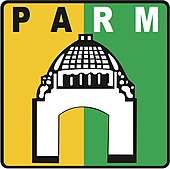
The Party has been very authoritarian and hierarchical, leaving little room for opposition. However, it was not interested in oppression for its own sake. Its main goal was to keep order, preferring pragmatism over ideology. Throughout its rule in post-revolutionary Mexico, it avoided empowering one faction too much, preferring to build its own ruling caste rather than side with another. It tended to play off both sides of the political spectrum, both the populists and the emerging middle class.
The tradition of strong-man rule was not completely thrown away, presidentialism (presidencialismo), the political arrangement of a powerful executive branch centered in the presidency, became the favored style of post-revolutionary politics.[195]
In 1988, Cuauhtémoc Cárdenas, son of president Lázaro Cárdenas, broke with the PRI, forming an independent leftist party, the Party of the Democratic Revolution, or PRD. It is not by chance that the party used the word "Revolution" in its name, challenging the Institutional Revolutionary Party's appropriation of the Mexican Revolution. Earlier, there was a leftist party the Authentic Party of the Mexican Revolution, which never functioned as a full political party fielding presidential candidates, but asserted its legitimacy as the party of Revolution in Mexico until its demise.
In this the Mexican Revolution was not revolutionary, only making the mechanisms of power less autocratic and more efficient in the attainment of its interests. Octavio Paz wrote that the revolution strengthened the Mexican state more than ever, making Mexico a very state-centered and patrimonialist society. In such a development they betrayed their acknowledged liberal predecessors of the Restored Republic of 1867–1876 which saw the most significant break from authoritarian politics in Mexico's history.[196]
A more modern legacy is that of another insurgency from the 1990s, taking its name from Emiliano Zapata, the Zapatista Army of National Liberation (Ejécito Zapatista de Liberación Nacional). The neo-Zapatista revolt began in Chiapas, which was very reliant and supportive of the revolutionary reforms, especially the ejido system, which it had pioneered before Cárdenas took power. Most revolutionary gains were reversed in the early 1990s by President Salinas, who began moving away from the agrarian socialist policies of the late post revolution period in favor of modern capitalism. This culminated in the removal of the ejido system in Chiapas. The destruction of what little the poor starving peasants had caused them to revolt. Calling to Mexico's revolutionary heritage, the EZLN draws heavily from early revolutionary rhetoric. It is inspired by many of Zapata's policies, including a call for decentralized local rule.
Social changes
.svg.png)
The Mexican Revolution brought about various social changes. First, the leaders of the Porfiriato lost their political power (but kept their economic power), and the middle class started to enter the public administration. "At this moment the bureaucrat, the government officer, the leader were born […]".[197] The army opened the sociopolitical system and the leaders in the Constitutionalist faction, particularly Alvaro Obregón and Plutarco Elías Calles, controlled the central government for more than a decade after the military phase ended in 1920. The creation of the PNR in 1929 brought generals into the political system, but as an institution, the army's power as an interventionist force was tamed, most directly under Lázaro Cárdenas, who in 1936 incorporated the army as a sector in the new iteration of the party, the Revolutionary Party of Mexico (PRM). The old federal army had been destroyed during the revolution, and the new collection of revolutionary fighters were brought under state control.[198]
On the other hand, although the proportion between rural and urban population, and the number of workers and the middle class remained practically the same, the Mexican Revolution brought substantial qualitative changes to the cities. Big rural landlords moved to the city escaping from chaos in the rural areas. Some poor farmers also migrated to the cities and they settled on neighborhoods where the Porfiriato elite used to live. The standard of living in the cities grew: it went from contributing to 42% of the national GDP to 60% by 1940. However, social inequality remained.[199]
The greatest change occurred among the rural population. The agrarian reform allowed some revolutionary fighters to have access to land, (ejidos), that remained under control of the government. However, the structure of land ownership for ejidetarios did not promote rural development and impoverished even more the rural population.[200][201] "From 1934 to 1940 wages fell 25% on rural areas, while for city workers wages increased by 20%".[202] "There was a lack of food, there was not much to sell and even less to buy. […] the habit of sleeping in the floor remains, […] diet is limited to beans, tortilla, and chili pepper; clothing is poor".[203] Peasants temporarily migrated to other regions to work in the production of certain crops where they were frequently exploited, abused, and suffered from various diseases. Others decided to migrate to the United States.[204]
See also
- Mexican Border War (1910–1919)
- Porfirio Díaz
- Porfiriato
- Economic history of Mexico
- Factions in the Mexican Revolution
- Index of Mexico-related articles
- La Adelita
- List of wars involving Mexico
- Partido Revolucionario Institucional
- Soldaderas
- United States involvement in the Mexican Revolution
References
- "Obregón Salido Álvaro". Bicentenario de México. Retrieved 2 May 2013.
- "Elías Calles Campuzano Plutarco". Bicentenario de México. Retrieved 2 May 2013.
- Robert McCaa, "Missing millions: the human cost of the Mexican Revolution." Mexican Studies 19#2 (2001). online
- Rummel, Rudolph. "Tavle 11.1 The Mexican Democide Line 39". Statistics Of Mexican Democide.
- Rummel, Rudolph. "Tavle 11.1 The Mexican Democide Line 46". Statistics Of Mexican Democide.
- Alan Knight, "Mexican Revolution: Interpretations" in Encyclopedia of Mexico, vol. 2, p. 873. Chicago: Fitzroy Dearborn 1997.
- John Tutino, From Insurrection to Revolution: Social Bases of Agrarian Violence, 1750–1940. Princeton: Princeton University Press 1986, p. 327.
- Friedrich Katz, The Secret War in Mexico: Europe, the United States and the Mexican Revolution. Chicago: University of Chicago Press, 1981, p. 35.
- Katz, The Secret War in Mexico p. 35.
- Tuñon Pablos, "Mexican Revolution: February 1913 – October 1915", p. 855
- "Mexican Revolution 1910–1920".
- Christon Archer, "Military, 1821–1914" in Encyclopedia of Mexico, vol. 2, p. 910. Chicago: Fitzroy and Dearborn 1997.
- Friedrich Katz, The Secret War in Mexico: Europe, the United States and the Mexican Revolution. Chicago: University of Chicago Press 1981.
- Michael LaRosa and German R. Mejia (2007). An Atlas and Survey of Latin American History. M.E. Sharpe. p. 150. ISBN 978-0-7656-2933-3.
- John Womack, Jr. "The Mexican Revolution" in Mexico Since Independence, ed. Leslie Bethell. Cambridge: Cambridge University Press 1991, p. 125
- Knight,"Mexican Revolution: Interpretations", pp. 869–873.
- Knight, Alan (1 May 1980). "The Mexican Revolution". History Today. 30 (5): 28. Retrieved 5 November 2011.
- Cockcroft, James (1992). Mexico: Class Formation, Capital Accumulation, & the State. Monthly Review Press.
- Centeno, Ramón I. (1 February 2018). "Zapata reactivado: una visión žižekiana del Centenario de la Constitución". Mexican Studies/Estudios Mexicanos. 34 (1): 36–62. doi:10.1525/msem.2018.34.1.36. ISSN 0742-9797.
- James A. Garza, "Porfirio Díaz", in Encyclopedia of Mexico, vol. 1, p. 406. Chicago: Fitzroy Dearborn, 1997
- Paul Garner, Porfirio Díaz. New York: Pearson 2001, p. 98.
- Garner, Porfirio Díaz, p. 98.
- Garner, Porfirio Díaz, p. 253.
- Garner, Porfirio Díaz, p. 242.
- Garner, Porfirio Díaz, p. 245
- Garner, Porfirio Díaz, p. 246.
- William Weber Johnson, Heroic Mexico: The Violent Emergence of a Modern Nation, Doubleday, 1968, p. 69.
- Emily Edmonds-Poli and David A. Shirk (2012). Contemporary Mexican Politics. Rowman & Littlefield. p. 28. ISBN 9781442207561.
- John Womack, Jr. "The Mexican Revolution", in Mexico Since Independence, Leslie Bethell, ed. Cambridge: Cambridge University Press 1991, p. 130.
- Paul Vanderwood, Disorder and Progress: Bandits, Police, and Mexican Development. Wilmington, DE: SR Books, rev. ed. 1992.
- John Coatsworth, Growth Against Development: The Economic Impact of Railroads in Porfirian Mexico. DeKalb: Northern Illinois University Press, 1981.
- Deborah J. Baldwin, Protestants and the Mexican Revolution. Urbana: University of Illinois Press, 1990, p. 68.
- Friedrich Katz, The Secret War in Mexico. Chicago: University of Chicago Press, 1991.
- John Tutino, From Insurrection to Revolution: Social Bases of Agrarian Violence in Mexico, 1750–1940. Princeton: Princeton University Press 1986.
- Claudio Lomnitz citing Francisco Bulnes, El verdadero Díaz y la revolución in Claudio Lomnitz, The Return of Ricardo Flores Magón. New York: Zone Books, 2014, p. 55 and fn. 6, p. 533.
- Meade, "A History of Latin America: 1800 to the Present," pp. 323.
- John Kenneth Turner, Barbarous Mexico, Austin: University of Texas Press, 1969, reprint of the 1910 edition, pp. 181–186.
- Turner, Barbarous Mexico, pp. 167–173.
- Turner, Barbarous Mexico, pp. 181–186.
- Meade, "A History of Latin America: 1800 to the Present," pp. 323-324.
- Turner, Barbarous Mexico, p. 173, emphasis in the original quotation from Turner's informant.
- Garner, Paul. Porfirio Díaz. New York: Pearson, 2001, p. 209.
- Garner, Porfirio Díaz, p. 209.
- Garner, Porfirio Díaz p. 210.
- Garner, Porfirio Díaz p. 210
- McLynn, Frank. Villa and Zapata, p. 24.
- Womack, John. Zapata and the Mexican Revolution, p. 10.
- Johnson, William. Heroic Mexico, p41.
- Garner, Porfirio Díaz, p. 210.
- Mark Wasserman, "Francisco Vázquez Gómez", in Encyclopedia of Mexico, vol 2, p. 151. Chicago: Fitzroy Dearborn, 1997.
- Clayton, Lawrence A.; Conniff, Michael L. (2005). A History of Modern Latin America. United States: Wadsworth Publishing. pp. 285–286. ISBN 0-534-62158-9.
- Womack, John, Jr. "The Mexican Revolution" in Mexico Since Independence Leslie Bethell, ed. Cambridge: Cambridge University Press, 1991, p. 130.
- Womack, "The Mexican Revolution", p. 131.
- Taylor, Laurence D. "The Magonista Revolt in Baja California". The Journal of San Diego History 45(1)1999.
- Jacques, Leo M. Dambourges. Autumn 1974 "The Chinese Massacre in Torreon (Coahuila) in 1911". Arizona and the West, University of Arizona Press, volume 16, no. 3 1974, pp. 233–246
- Wasserman, "Francisco Vázquez Gómez", p. 1522.
- Cumberland, Charles C. Mexican Revolution: Genesis Under Madero. Austin: University of Texas Press 1952, p. 150.
- quoted in Cumberland, Mexican Revolution, p. 151.
- Knight, The Mexican Revolution, vol. 1, p. 203.
- quoted in Friedrich Katz, The Secret War in Mexico. Chicago: University of Chicago Press 1981, pp. 40-41.
- Henderson, Peter V.N. "Francisco de la Barra" in Encyclopedia of Mexico, Chicago: Fitzroy Dearborn 1997, p. 397.
- Ross, Stanley R. Francisco I. Madero: Apostle of Democracy, pp. 188-202.
- Katz, Friedrich. The Life and Times of Pancho Villa. Stanford: Stanford University Press 1998, pp. 114–118.
- quoted in Katz, The Life and Times of Pancho Villa, p. 117.
- Katz, Friedrich. The Secret War in Mexico, Chicago: University of Chicago Press 1981, 48.
- Cumberland, Charles C. Mexican Revolution: The Constitutionalist Years. Austin: University of Texas Press 1972, pp. 252–53.
- Lear, John. "Casa del Obrero Mundial" in Encyclopedia of Mexico, vol. 1, pp. 206–07. Chicago: Fitzroy Dearborn 1997.
- Knight, The Mexican Revolution, vol. 1, pp. 397–404.
- Knight, Alan. The Mexican Revolution, vol. 2, p. 77.
- Alan Knight, Mexican Revolution, vol. 2. Counter-revolution and Reconstruction. Lincoln: University of Nebraska Press 1986, 503.
- Knight, Mexican Revolution, vol. 2, p. 503
- Alan Knight, The Mexican Revolution, vol. 1. Porfirians, Liberals, and Peasants. Lincoln: University of Nebraska Press 1986, p. 402.
- Knight, The Mexican Revolution, vol. 1, p. 400.
- Knight, The Mexican Revolution, vol. 1, p. 403.
- Knight, The Mexican Revolution, vol. 1, p. 402.
- Knight, The Mexican Revolution, vol. 1, p. 404.
- Shadle, Stanley F. Andrés Molina Enríquez: Mexican Land Reformer of the Revolutionary Era. Tucson: University of Arizona Press 1994.
- Southern Methodist University, Central University Libraries, DeGolyer Library. See:digitalcollections.smu.edu/cdm/ref/collection/mex/id/508
- Knight, The Mexican Revolution, vol. 1, pp. 289–90, 554, fn. 259.
- Meyer, Michael C. Mexican Rebel: Pascual Orozco and the Mexican Revolution, 1910-1915 . Lincoln: University of Nebraska Press 1967, pp. 138-147
- Richmond, Douglas W. "Victoriano Huerta" in Encyclopedia of Mexico, vol. 1, p. 656. Chicago: Fitzroy Dearborn 1997.
- Katz, Katz. The Life and Times of Pancho Villa 1998, p. 165.
- Richmond, "Victoriano Huerta", p. 656.
- Tuñon Pablos, Esperanza. "Mexican Revolution: February 1913 – October 1915," in Encyclopedia of Mexico, vol. 2, 855–56.Chicago: Fitzroy Dearborn 1997. p. 855.
- Album, Mexican Revolution
- quoted in Katz, The Life and Times of Pancho Villa, pp. 196–97.
- Tuñon Pablos, "Mexican Revolution: February 1913 – October 1915", p. 855
- Katz, The Secret War in Mexico, p. 114.
- Katz, The Life and Times of Pancho Villa, p. 196.
- Richmond, Douglas W., "Victoriano Huerta" in Encyclopedia of Mexico, vol. 1. p. 655. Chicago: Fitzroy Dearborn 1997.
- Michael C. Meyer, Huerta: A Political Portrait. Lincoln: University of Nebraska Press 1972.
- Tuñon Pablos, Esperanza. "Mexican Revolution: February 1913 – October 1915" in Encyclopedia of Mexico, vol. 2, p. 656. Chicago: Fitzroy Dearborn 1997.
- Katz, The Secret War in Mexico pp. 92-118.
- Knight, Alan. "Venustiano Carranza" in Encyclopedia of Latin American History and Culture, vol. 1, p. 573. New York: Charles Scribner's Sons 1996.
- Knight, The Mexican Revolution, Volume 2, pp. 63–64.
- Knight, Mexican Revolution, vol. 2, p. 77.
- Shadle, Andrés Molina Enríquez: Mexican Land Reformer of the Revolutionary Era. pp. 62–64.
- Shadle, Andrés Molina Enríquez, pp. 62–63.
- Meyer, Huerta, p. 165.
- Shadle, Molina Enríquez, p. 63.
- Richmond, Douglas W., "Victoriano Huerta" in Encyclopedia of Mexico, vol. 1, p. 657. Chicago: Fitzroy Dearborn 1997.
- Homa, Gabriel. Actions Behind the Rhetoric: The Foreign Policy Practices of Woodrow Wilson. Issuu (Undergraduate). Retrieved 18 March 2018.
- Katz, The Secret War in Mexico, p. 167
- Katz, The Secret War in Mexico, p. 167.
- Knight, The Mexican Revolution, vol. 2, pp. 73–74.
- Knight, The Mexican Revolution, vol. 2, p. 74.
- Knight, The Mexican Revolution, vol. 2, p. 75.
- Knight, The Mexican Revolution, vol. 2, pp. 76–77.
- Knight, The Mexican Revolution, vol. 2, p. 77.
- Knight, The Mexican Revolution, vol. 2, p. 77
- Knight, The Mexican Revolution, vol. 2, pp. 77–78.
- Knight, The Mexican Revolution, vol. 2, p. 79.
- Krauze, Enrique;"The April Invasion of Veracruz",The New York Times, 20 April 2014.
- Alan McPherson (2013) Encyclopedia of U.S. Military Interventions in Latin America, p. 393, ABC-CLIO, USA.
- Susan Vollmer (2007) Legends, Leaders, Legacies, p. 79, Biography & Autobiography, USA.
- Katz, The Secret War in Mexico, pp. 247–48
- Richmond, Douglas W., "Victoriano Huerta," in Encyclopedia of Mexico, vol. 1, p. 658. Chicago: Fitzroy Dearborn 1997.
- Archer, Christon I. "Military, 1821–1914" in Encyclopedia of Mexico, vol. 2, p. 910. Chicago: Fitzroy Dearborn 1997.
- Hart, Revolutionary Mexico, p. 276.
- Knight, "Venustiano Carranza", p. 573.
- Tuñon Pablos, Esperanza. "Mexican Revolution: February 1913 – October 1915" in Encyclopedia of Mexico, p. 858. Chicago: Fitzroy Dearborn 1997.
- Katz, Friedrich. The Secret War in Mexico: Europe, the United States, and the Mexican Revolution. Chicago: University of Chicago Press 1981, p. 258.
- Carranza quoted in Enrique Krauze, Mexico: Biography of Power, p. 349.
- Tuñon Pablos, "Mexican Revolution: February 1913 – October 1915" p. 858.
- Tuñon Pablos, "Mexican Revolution," p. 858.
- Cumberland, Mexican Revolution: Constitutionalist Years, p. 180.
- Cumberland, Mexican Revolution: Constitutionalist Years, p. 181.
- Knight, Alan. "Venustiano Carranza" in Encyclopedia of Latin American History and Culture, vol. 1, pp. 573-75
- Brunk, Samuel. "Emiliano Zapata" in Encyclopedia of Latin American History and Culture, vol. 5, p. 494. New York: Charles Scribner's Sons 1996.
- Alvaro Matute, "Mexican Revolution: May 1917 – December 1920" in Encyclopedia of Mexico, vol. 2, p. 862. Chicago: Fitzroy Dearborn 1997.
- Matute, "Mexican Revolution: May 1917 – December 1920", p. 863.
- Mirande, Alfredo; Enriquez, Evangelina. (1981). La Chicana: The Mexican-American Woman. United States: University of Chicago Press. pp. 217–219. ISBN 978-0-226-53160-1.
- Knight, "Venustiano Carranza" p. 574.
- Markiewicz, Dana. The Mexican Revolution and the Limits of Agrarian Reform, 1915-1946. Boulder: Lynne Rienner Publisher 1993, p. 31.
- Katz, The Secret War in Mexico, p. 296.
- Busky, Donald F. Democratic Socialism: A Global Survey
- Castillo, Máximo (2016). Valdés, Jesús Vargas (ed.). Máximo Castillo and the Mexican Revolution. Translated by Aliaga-Buchenau, Ana-Isabel. Baton Rouge, Louisiana: Louisiana State University Press. pp. 51–58. ISBN 978-0807163887.
- Katz, The Secret War, p. 297.
- Katz, The Life and Times of Pancho Villa 1998, p. 569.
- John Whiteclay Chambers; Fred Anderson (1999). The Oxford Companion to American Military History. Oxford University Press. p. 432.
- Knight,"Venustiano Carranza" vol. 1, pp. 574-75
- Knight, "Venustiano Carranza" vol. 1, pp. 574-75
- Philip Russell (2011). The History of Mexico: From Pre-Conquest to Present. Routledge. pp. 334–38. ISBN 9781136968280.
- Benjamin, La Revolución, p. 91.
- Knight, "Venustiano Carranza, vol. 1. pp. 574.
- Wasserman, Mark. "Francisco "Pancho" Villa" in Encyclopedia of Latin American History and Culture, vol. 5, p. 416.
- Archivo General de la Nación, Mexico City, Archivo Fotográfico, Delgado y García)
- Katz, The Secret War in Mexico, pp. 123-24.
- Womack, John Jr., Zapata and the Mexican Revolution (1968)
- McNeely, John H. "Origins of the Zapata revolt in Morelos." Hispanic American Historical Review (1966): 153–169.
- Brunk, Samuel. "Emiliano Zapata" vol. 5, p. 494.
- Russell (2011). The History of Mexico: From Pre-Conquest to Present. pp. 338–41. ISBN 9781136968280.
- Russell (2011). The History of Mexico: From Pre-Conquest to Present. pp. 341–44. ISBN 9781136968280.
- Russell (2011). The History of Mexico: From Pre-Conquest to Present. pp. 347–48. ISBN 9781136968280.
- Russell (2011). The History of Mexico: From Pre-Conquest to Present. pp. 348–53. ISBN 9781136968280.
- Coffey, Mary. How a Revolutionary Art Became Official Culture: Murals, Museums, and the Mexican State. Durham: Duke University Press 2012.
-
- Folgarait, Leonard. Mural Painting and Social Revolution in Mexico, 1920–1940. Cambridge: Cambridge University Press 1998.
- Barajas, Rafael. Myth and Mitote: The Political Caricature of José Guadalupe Posada and Manuel Alfonso Manila. Mexico City: Fondo de Cultura Económica 2009
- Ades, Dawn and Alison McClean, Revolution on Paper: Mexican Prints 1910-1960. Austin: University of Texas Press 2009, p. 18.
- Britton, John A. Revolution and Ideology Images of the Mexican Revolution in the United States. Louisville: The University Press of Kentucky, 1995.
- Ades, Dawn. "The Mexican Printmaking Tradition, c. 1900-1930" in Revolution on Paper, p. 11.
- Ades, Revolution on Paper, catalogue 22, pp. 76-77
- Photograph by Antonio Gómes Delgado El Negro, Casasola Archive, Mexico
- John Mraz, Photographing the Mexican Revolution, Austin: University of Texas Press 2012, pp. 246–47. Inv. #287647. Casasola Archive. SINAFO-Fototeca Nacional de INAH.
- Chilcote, Ronald H. "Introduction" Mexico at the Hour of Combatp. 9.
- Debroise, Olivier. Mexican Suite, p. 177.
- Vanderwood, Paul J. and Frank N. Samponaro. Border Fury: A Picture Postcard Record of Mexico's Revolution and U.S. War Preparedness, 1910-1917. Albuquerque: University of New Mexico Press 1988.
- Debroise, Mexican Suite, p. 178.
- Pick, Constructing the Image of the Mexican Revolution, p. 2
- Pick, Constructing the Image of the Revolution, pp.41-54
- Herrera Sobek, María, The Mexican Corrido: A Feminist Analysis. Bloomington: Indiana University Press 1990
- Simmons, Merle. The Mexican corrido as a source of interpretive study of modern Mexico, 1900–1970. Bloomington: Indiana University Press 1957
- Rutherford, John D. Mexican society during the Revolution: a literary approach. Oxford: Oxford University Pres 1971.
- Klahn, Norma. "Nellie Campobello" in Encyclopedia of Mexico. Chicago: Fitzroy Dearborn 1997, p. 187.
- Camp, Roderic Ai. "Martín Luis Guzmán" in Encyclopedia of Latin American History and Culture, vol. 3, p. 157. New York: Charles Scribner's Sons 1996.
- Perea, Héctor. "Martín Luis Guzmán Franco" in Encyclopedia of Mexico. Chicago: Fitzroy Dearborn 1997, pp. 622-23.
- The Green Guide: Mexico, Guatemala and Belize. London: Michelin 2011,149.
- Rubén Osorio Zúñiga, "Francisco (Pancho) Villa" in Encyclopedia of Mexico, vol. 2. p. 1532. Chicago: Fitzroy Dearborn 1997.
- Jürgen Buchenau, "The Arm and Body of the Revolution: Remembering Mexico's Last Caudillo, Álvaro Obregón" in Lyman L. Johnson, ed. Body Politics: Death, Dismemberment, and Memory in Latin America. Albuquerque: University of New Mexico Press 2004, pp. 179–207.
- Fabrizio Mejía Madrid, "Insurgentes" in The Mexico City Reader, ed. Rubén Gallo. Madison: University of Wisconsin Press 2004, p. 63.
- Samuel Brunk, The Posthumous Career of Emiliano Zapata. Austin: University of Texas Press 2008, pp. 67–69.
- Image of the Zapata banknote that was previously on Wiki Commons has been deleted.
- image of the statue in Thomas Benjamin, La Revolución, p. 86.
- Perhaps enough time had passed since the Revolution and Romero Rubio was just a name with no historical significance to ordinary Mexicans. In 2000, the Institutional Revolutionary Party lost the presidential election to the candidate of the National Action Party.
- Enrique Krauze, Mexico: Biography of Power. New York: HarperCollins 1997, p. 373.
- Gabriela Cano, "Soldaderas and Coronelas" in Encyclopedia of Mexico, vol. 1, pp. 1357–1360. Chicago: Fitzroy Dearborn 1997.
- Krauze, Enrique. Mexico: Biography of Power, p. 373.
- Meyer, Jean. "Revolution and Reconstruction in the 1920s" in Mexico since Independence, Leslie Bethell, ed. New York: Cambridge University Press 1991, p. 201
- Womack John. "The Mexican Revolution, 1910-1920" in Mexico since Independence, Leslie Bethell, ed. New York: Cambridge University Press 1991, p.200.
- Meyer, "Revolution and Reconstruction in the 1920s", p. 202.
- Roberto Blancarte, "Recent Changes in Church-State Relations in Mexico: An Historical Approach." Journal of Church & State, Autumn 1993, vol. 35. No. 4.
- Knight, Alan "The Myth of the Mexican Revolution" pages 223–273 from Past & Present, No. 209, November 2010 page 224.
- Knight, Alan "The Myth of the Mexican Revolution" pages 223–273 from Past & Present, No. 209, November 2010 pages 226–227.
- Knight, Alan "The Myth of the Mexican Revolution" pages 223–273 from Past & Present, No. 209, November 2010 page 228.
- "Mexico and Russia: Mirror Images?" (PDF). George Washington University. Retrieved 8 June 2013.
- The Philanthropic Ogre, 1979.
- Meyer, Jean (2004). La Revolución mexicana. Mexico: Tusquets. p. 294. ISBN 978-607-421-141-2.
- Lieuwen, Edward. Mexican Militarism: The Political Rise and fall of the Revolutionary Army, 1919–1940. Albuquerque: University of New Mexico Press, 1968.
- Meyer, Jean (2004). La Revolucion mexicana. Mexico: Tusquets. pp. 297–298. ISBN 978-607-421-141-2.
- Appendini, Kirsten. "Ejido" in The Encyclopedia of Mexico. p. 450. Chicago: Fitzroy and Dearborn 1997.
- Meyer, Jean (2004). La Revolucion mexicana. Mexico: Tusquets. p. 299. ISBN 978-607-421-141-2.
- Meyer, Jean (2004). La Revolucion mexicana. Mexico: Tusquets. p. 303. ISBN 978-607-421-141-2.
- Meyer, Jean (2004). La Revolucion mexicana. Mexico: Tusquets. p. 205. ISBN 978-607-421-141-2.
- Meyer, Jean (2004). La Revolucion mexicana. Mexico: Tusquets. p. 304. ISBN 978-607-421-141-2.
- Many portions of this article are translations of excerpts from the article Revolución Mexicana in the Spanish Wikipedia.
Further reading
Mexican Revolution – general histories
- Brenner, Anita. The Wind that Swept Mexico. New Edition. Austin: University of Texas Press 1984.
- Brewster, Keith. "Mexican Revolution: October 1910 – February 1913" in Encyclopedia of Mexico, vol. 2, pp. 850–855. Chicago: Fitzroy Dearborn 1997.
- Crossen, John F. "Mexican Revolution: October 1915 – May 1917" in Encyclopedia of Mexico, vol. 2, pp. 859–862. Chicago: Fitzroy Dearborn 1997.
- Cumberland, Charles C. Mexican Revolution: Genesis under Madero. Austin: University of Texas Press 1952.
- Cumberland, Charles C. Mexican Revolution: The Constitutionalist Years. Austin: University of Texas Press 1972.
- Gilly, A. The Mexican Revolution. London 1983.
- Gonzales, Michael J. The Mexican Revolution: 1910–1940. Albuquerque: University of New Mexico Press, 2002.
- Hart, John Mason. Revolutionary Mexico: The Coming and Process of the Mexican Revolution. Berkeley and Los Angeles: University of California Press 1987.
- Katz, Friedrich. The Secret War in Mexico: Europe, the United States, and the Mexican Revolution. Chicago: University of Chicago Press 1981.
- Knight, Alan. The Mexican Revolution, Volume 1: Porfirians, Liberals, and Peasants (1986); The Mexican Revolution, Volume 2: Counter-revolution and Reconstruction. University of Nebraska Press 1986.
- Krauze, Enrique. Mexico: Biography of Power. New York: HarperCollins 1997.
- Matute, Alvaro. "Mexican Revolution: May 1917 – December 1920" in Encyclopedia of Mexico, vol. 2, pp. 862–864. Chicago: Fitzroy Dearborn 1997.
- Niemeyer, Victor E. Revolution at Querétaro: The Mexican Constitutional Convention of 1916–1917. Austin: University of Texas Press 1974.
- Quirk, Robert E. The Mexican Revolution, 1914–1915: The Convention of Aguascalientes. New York: The Citadel Press 1981.
- Quirk, Robert E. The Mexican Revolution and the Catholic Church 1910–1919. Bloomington: Indiana University Press, 1973
- Ruiz, Ramón Eduardo. The Great Rebellion: Mexico, 1905–1924. New York: Norton 1980.
- Tuñon Pablos, Esperanza. "Mexican Revolution: February 1913 – October 1915," in Encyclopedia of Mexico, vol. 2, pp. 855–859 . Chicago: Fitzroy Dearborn 1997
- Tutino, John. From Insurrection to Revolution. Princeton: Princeton University Press 1985.
- Wasserman, Mark. The Mexican Revolution: A Brief History with Documents. (Bedford Cultural Editions Series) First Edition, 2012.
- Wilkie, James. The Mexican Revolution: Federal Expenditure and Social Change since 1910. Berkeley and Los Angeles: University of California Press 1967.
- Womack, John, Jr. "The Mexican Revolution" in The Cambridge History of Latin America, vol. 5 ed. Leslie Bethell. Cambridge: Cambridge University Press 1986.
Biography and social history
- Baldwin, Deborah J. Protestants and the Mexican Revolution: Missionaries, Ministers, and Social Change. Urbana: University of Illinois Press 1990.
- Beezley, William H. Insurgent Governor: Abraham González and the Mexican Revolution in Chihuahua. Lincoln: University of Nebraska Press 1973.
- Brunk, Samuel. Emiliano Zapata: Revolution and Betrayal in Mexico. Albuquerque: University of New Mexico Press 1995.
- Buchenau, Jürgen, Plutarco Elías Calles and the Mexican Revolution. Lanham MD: Rowman and Littlefied 2007.
- Buchenau, Jürgen. The Last Caudillo: Alvaro Obregón and the Mexican Revolution. Malden MA: Wiley-Blackwell 2011.
- Caballero, Raymond (2015). Lynching Pascual Orozco, Mexican Revolutionary Hero and Paradox. Create Space. ISBN 978-1514382509.
- Cockcroft, James D. Intellectual Precursors of the Mexican Revolution. Austin: University of Texas Press 1968.
- Fisher, Lillian Estelle. "The Influence of the Present Mexican Revolution upon the Status of Mexican Women," Hispanic American Historical Review, Vol. 22, No. 1 (Feb. 1942), pp. 211–228.
- Garner, Paul. Porfirio Díaz. New York: Pearson 2001.
- Guzmán, Martín Luis. Memoirs of Pancho Villa. Translated by Virginia H. Taylor. Austin: University of Texas Press 1966.
- Hall, Linda. Alvaro Obregón, Power, and Revolution in Mexico, 1911–1920. College Station: Texas A&M Press 1981.
- Henderson, Peter V.N. In the Absence of Don Porfirio: Francisco León de la Barra and the Mexican Revolution. Wilmington, Del.: Scholarly Resources 2000
- Katz, Friedrich. The Life and Times of Pancho Villa. Stanford: Stanford University Press 1998.
- Lomnitz, Claudio. The Return of Comrade Ricardo Flores Magón. Brooklyn NY: Zone Books 2014.
- Lucas, Jeffrey Kent. The Rightward Drift of Mexico's Former Revolutionaries: The Case of Antonio Díaz Soto y Gama. Lewiston, New York: Edwin Mellen Press, 2010.
- Macias, Anna. "Women and the Mexican Revolution, 1910–1920." The Americas, 37:1 (Jul. 1980), 53–82.
- Meyer, Michael. Huerta: A Political Portrait. Lincoln: University of Nebraska Press 1972.
- Meyer, Michael. Mexican Rebel: Pascual Orozco and the Mexican Revolution, 1910–1915. Lincoln: University of Nebraska Press 1967.
- Poniatowska, Elena. Las Soldaderas: Women of the Mexican Revolution. Texas: Cinco Puntos Press; First Edition, November 2006
- Reséndez, Andrés. "Battleground Women: Soldaderas and Female Soldiers in the Mexican Revolution." The Americas 51, 4 (April 1995).
- Ross, Stanley R. Francisco I. Madero: Apostle of Democracy. New York: Columbia University Press 1955.
- Richmond, Douglas W. Venustiano Carranza's Nationalist Struggle: 1893–1920. Lincoln: University of Nebraska Press 1983.
- Shadle, Stanley F. Andrés Molina Enríquez: Mexican Land Reformer of the Revolutionary Era. Tucson: University of Arizona Press 1994.
- Smith, Stephanie J. Gender and the Mexican Revolution: Yucatán Women and the Realities of Patriarchy. North Carolina: University of North Carolina Press, 2009
- Womack, John, Jr. Zapata and the Mexican Revolution. New York: Vintage Press 1970.
Regional histories
- Benjamin, Thomas and Mark Wasserman, eds. Provinces of the Revolution. Albuquerque: University of New Mexico Press 1990.
- Blaisdell, Lowell. The Desert Revolution, Baja California 1911. Madison: University of Wisconsin Press 1962.
- Brading, D.A., ed. Caudillo and Peasant in the Mexican Revolution. Cambridge: Cambridge University Press 1980.
- Joseph, Gilbert. Revolution from Without: Yucatán, Mexico, and the United States, 1880–1924. Cambridge: Cambridge University Press 1982.
- Harris, Charles H. III. The Secret War in El Paso: Mexican Revolutionary Intrigue, 1906–1920. Albuquerque: University of New Mexico Press 2009.
- Jacobs, Ian. Ranchero Revolt: The Mexican Revolution in Guerrero. Austin: University of Texas Press 1983.
- LaFrance, David G. The Mexican Revolution in Puebla, 1908–1913: The Maderista Movement and Failure of Liberal Reform. Wilmington, DL: Scholarly Resources 1989.
- Snodgrass, Michael. Deference and Defiance in Monterrey: Workers, Paternalism, and Revolution in Mexico, 1890–1950. Cambridge University Press. 2003.
- Wasserman, Robert. Capitalists, Caciques, and Revolution: The Native Elites and Foreign Enterprise in Chihuahua, Mexico, 1854–1911. Chapel Hill: University of North Carolina Press 1984.
International dimensions
- Buchenau, Jürgen, "Mexican Revolution: Foreign Intervention" in Encyclopedia of Mexico, vol. 2, pp. 865–869. Chicago: Fitzroy Dearborn 1997.
- Clendenin, Clarence C. The United States and Pancho Villa: A study in unconventional diplomacy. Ithaca: Cornell University Press 1981.
- Cline, Howard F. The United States and Mexico. 2nd edition. Cambridge: Harvard University Press 1961.
- Gilderhus, M.T. Diplomacy and Revolution: U.S.-Mexican Relations under Wilson and Carranza. Tucson: University of Arizona Press 1977.
- Grieb, K.J. The United States and Huerta. Lincoln: University of Nebraska Press 1969.
- Haley, P. E. Revolution and Intervention: The diplomacy of Taft and Wilson with Mexico, 1910–1917. Cambridge, 1970.
- Hart, John Mason. Empire and Revolution: The Americans in Mexico since the Civil War. Berkeley and Los Angeles: University of California Press 2002.
- Katz, Friedrich. The Secret War in Mexico: Europe, the United States, and the Mexican Revolution. Chicago: University of Chicago Press 1981.
- Meyer, Lorenzo. The Mexican Revolution and the Anglo-Saxon Powers. LaJolla: Center for U.S.-Mexico Studies. University of California San Diego, 1985.
- Quirk, Robert E. An Affair of Honor: Woodrow Wilson and the Occupation of Veracruz. Louisville: University of Kentucky Press 1962.
- Stefan Rinke, Michael Wildt (eds.): Revolutions and Counter-Revolutions. 1917 and its Aftermath from a Global Perspective. Campus 2017.
- Smith, Robert Freeman. The United States and Revolutionary Nationalism in Mexico 1916–1932. Chicago: University of Chicago Press, 1972.
- Teitelbaum, Louis M. Woodrow Wilson and the Mexican Revolution. New York: Exposition Press 1967.
Memory and cultural dimensions
- Benjamin, Thomas. La Revolución: Mexico's Great Revolution as Memory, Myth, and History. Austin: University of Texas Press 2000.
- Brunk, Samuel. The Posthumous Career of Emiliano Zapata: Myth, Memory, and Mexico's Twentieth Century. Austin: University of Texas Press 2008.
- Buchenau, Jürgen. "The Arm and Body of a Revolution: Remembering Mexico's Last Caudillo, Álvaro Obregón" in Lyman L. Johnson, ed. Body Politics: Death, Dismemberment, and Memory in Latin America. Albuquerque: University of New Mexico Press 2004, pp. 179–207
- Foster, David, W., ed. Mexican Literature: A History. Austin: University of Texas Press, 1994.
- Hoy, Terry. "Octavio Paz: The Search for Mexican Identity." The Review of Politics 44:3 (July 1982), 370–385.
- Gonzales, Michael J. "Imagining Mexico in 1921: Visions of the Revolutionary State and Society in the Centennial Celebration in Mexico City," Mexican Studies/Estudios Mexicanos vol. 25. No 2, Summer 2009, pp. 247–270.
- Herrera Sobek, María, The Mexican Corrido: A Feminist Analysis. Bloomington: Indiana University Press 1990.
- Oles, James, ed. South of the Border, Mexico in the American Imagination, 1914–1947. New Haven: Yale University Art Gallery 1993.
- O'Malley, Ilene V. 1986. The Myth of the Revolution: Hero Cults and the Institutionalization of the Mexican State, 1920–1940. Westport: Greenwood Press
- Ross, Stanley, ed. Is the Mexican Revolution Dead?. Philadelphia: Temple University Press 1975.
- Rutherford, John D. Mexican society during the Revolution: a literary approach. Oxford: Oxford University Pres 1971.
- Simmons, Merle. The Mexican corrido as a source of interpretive study of modern Mexico, 1900–1970. Bloomington: Indiana University Press 1957.
- Vaughn, Mary K. Negotiating Revolutionary Culture: Mexico, 1930–1940. Tucson: University of Arizona Press 1997.
- Weinstock, Herbert. "Carlos Chavez." The Musical Quarterly 22:4 (Oct. 1936), 435–445.
Visual culture: prints, painting, film, photography
- Barajas, Rafael. Myth and Mitote: The Political Caricature of José Guadalupe Posada and Manuel Alfonso Manila. Mexico City: Fondo de Cultura Económica 2009
- Britton, John A. Revolution and Ideology Images of the Mexican Revolution in the United States. Louisville: The University Press of Kentucky, 1995.
- Coffey, Mary. How a Revolutionary Art Became Official Culture: Murals, Museums, and the Mexican State. Durham: Duke University Press 2012.
- Doremus, Anne T. Culture, Politics, and National Identity in Mexican Literature and Film, 1929–1952. New York: Peter Lang Publishing Inc., 2001.
- Elliott, Ingrid. "Visual Arts: 1910–37, The Revolutionary Tradition." Encyclopedia of Mexico. Chicago: Fitzroy Dearborn 1997, pp. 1576–1584.
- Flores, Tatiana. Mexico's Revolutionary Avant-Gardes: From Estridentismo to ¡30–30!. New Haven: Yale University Press 2013.
- Folgarait, Leonard. Mural Painting and Social Revolution in Mexico, 1920–1940. Cambridge: Cambridge University Press 1998.
- Ittman, John, ed. Mexico and Modern Printmaking, A Revolution in the Graphic Arts, 1920 to 1950. Philadelphia: Philadelphia Museum of Art 2006.
- McCard, Victoria L. Soldaderas of the Mexican revolution (The Evolution of War and Its Representation in Literature and Film), an article from West Virginia University Philological Papers 51 (2006), pgs. 43–51.
- Mora, Carl J., Mexican Cinema: Reflections of a Society 1896–2004. Berkeley: University of California Press, 3rd edition, 2005
- Myers, Bernard S. Mexican Painting in Our Time. New York: Oxford University Press, 1956.
- Mraz, John. Photographing the Mexican Revolution: Commitments, Testimonies, Icons. Austin: University of Texas Press 2012.
- Noble, Andrea, Photography and Memory in Mexico: Icons of Revolution. Manchester: Manchester University Press, 2010.
- Noble, Andrea, Mexican National Cinema, London: Routledge, 2005.
- Orellana, Margarita de, Filming Pancho Villa: How Hollywood Shaped the Mexican Revolution: North American Cinema and Mexico, 1911–1917. New York: Verso, 2007.
- Ortiz Monasterio, Pablo. Mexico: The Revolution and Beyond: Photographs by Agustín Victor Casasola, 1900–1940. New York: Aperture 2003.
- Paranagua, Paula Antonio. Mexican Cinema. London: British Film Institute, 1995.
- Pick, Zuzana M. Constructing the Image of the Mexican Revolution: Cinema and the Archive. Austin: University of Texas Press 2010.
- ¡Tierra y Libertad! Photographs of Mexico 1900–1935 from the Casasola Archive. Oxford: Museum of Modern Art 1985.ISBN 978-84-934426-51
Historiography
- Bailey, D. M. "Revisionism and the recent historiography of the Mexican Revolution." Hispanic American Historical Review 58#1 (1978), 62–79.
- Brunk, Samuel. The Posthumous Career of Emiliano Zapata. (University of Texas Press 2008)
- Golland, David Hamilton. "Recent Works on the Mexican Revolution." Estudios Interdisciplinarios de América Latina y el Caribe 16.1 (2014). online
- Knight, Alan. "Mexican Revolution: Interpretations" in Encyclopedia of Mexico, vol. 2, pp. 869–873. Chicago: Fitzroy Dearborn 1997.
- Knight, Alan. "The Mexican Revolution: Bourgeois? Nationalist? Or Just a 'Great Rebellion'?" Bulletin of Latin American Research (1985) 4#2 pp. 1–37 in JSTOR
- Knight, Alan. "Viewpoint: Revisionism and Revolution", Past and Present 134 (1992).
- McNamara, Patrick J. "Rewriting Zapata: Generational Conflict on the Eve of the Mexican Revolution." Mexican Studies-Estudios Mexicanos 30.1 (2014): 122–149.
- Tannenbaum, Frank. "Land Reform in Mexico". Annals of the American Academy of Political and Social Science, Vol. 150, Economics of World Peace (July 1930), 238–247. in JSTOR
- Van Young, Eric. "Making Leviathan Sneeze: Recent Works on Mexico and the Mexican Revolution," Latin American Research Review (1999) 34#2 pp. 143–165 in JSTOR
- Wasserman, Mark. "You Can Teach An Old Revolutionary Historiography New Tricks Regions, Popular Movements, Culture, and Gender in Mexico, 1820–1940," Latin American Research Review (2008) 43#2 260–271 in Project MUSE
- Womack, John Jr. "Mexican Revolution: Bibliographical Essay" in Mexico Since Independence, Leslie Bethell, ed. Cambridge: Cambridge University Press 1991, pp. 405–414.
Primary sources
- Angelini, Erin. "The Bigger Truth About Mexico"
- Bulnes, Francisco. The Whole Truth About Mexico: The Mexican Revolution and President Wilson's Part Therein, as seen by a Cientifico. New York: M. Bulnes Book Company 1916.
- O'Shaunessy, Edith. A Diplomat's Wife in Mexico. New York: Harper 1916.
- Reed, John. Insurgent México. New York: International Publishers, 1969.
- Turner, John Kenneth. Barbarous Mexico. Austin: University of Texas Press 1984.
- Wasserman, Mark. The Mexican Revolution: A Brief History with Documents. (Bedford Cultural Editions Series) First Edition, 2012.
Online
- Brunk, Samuel. The Banditry of Zapatismo in the Mexican Revolution The American Historical Review. Washington: April 1996, Volume 101, Issue 2, Page 331.
- Brunk, Samuel. "Zapata and the City Boys: In Search of a Piece of Revolution." Hispanic American Historical Review. Duke University Press, 1993.
- "From Soldaderas to Comandantes" Zapatista Direct Solidarity Committee. University of Texas.
- Gilbert, Dennis. "Emiliano Zapata: Textbook Hero." Mexican Studies. Berkley: Winter 2003, Volume 19, Issue 1, Page 127.
- Hardman, John. "Soldiers of Fortune" in the Mexican Revolution. "Postcards of the Mexican Revolution"
- Merewether Charles, Collections Curator, Getty Research Institute, "Mexico: From Empire to Revolution", Jan. 2002.
- Rausch George Jr. "The Exile and Death of Victoriano Huerta", The Hispanic American Historical Review, Vol. 42, No. 2, May 1963 pp. 133–151.
- Tuck, Jim. "Zapata and the Intellectuals." Mexico Connect, 1996–2006.
External links
| Wikimedia Commons has media related to Mexican Revolution. |
- Mexican Revolution from the Library of Congress at Flickr Commons
- Library of Congress—Hispanic Reading Room portal, Distant Neighbors: The U.S. and the Mexican Revolution
- Encyclopædia Britannica's article on The Mexican Revolution
- EDSITEment's Spotlight: The Centennial of the Mexican Revolution, 1910–2010 from EDSITEment, "The Best of the Humanities on the Web"
- U.S. Library of Congress Country Study: Mexico
- Mexican Revolution of 1910 and Its Legacy, latinoartcommunity.org
- Stephanie Creed, Kelcie McLaughlin, Christina Miller, Vince Struble, Mexican Revolution 1910–1920, Latin American Revolutions, course material for History 328, Truman State University (Missouri)
- Mexico: From Empire to Revolution, photographs and commentary on the site of the J. Paul Getty Trust
- Mexican Revolution, ca. 1910–1917 Photos and postcards in color and in black and white, some with manuscript letters, postmarks, and stamps from the collection at the Beinecke Rare Book and Manuscript Library at Yale University
- Papers of E. K. Warren & Sons, 1884–1973, ranchers in Mexico, Texas and New Mexico, held at Southwest Collection/Special Collections Library at Texas Tech University
- Mexican Revolution, in the "Children in History" website. This is an overview of the Revolution with a treatment of the impact on children.
- Mexico: Photographs, Manuscripts, and Imprints from the DeGolyer Library contains photographs related to the Mexican Revolution.
- Time line of the Mexican Revolution
- Elmer and Diane Powell Collection on Mexico and the Mexican Revolution from the DeGolyer Library, SMU.
